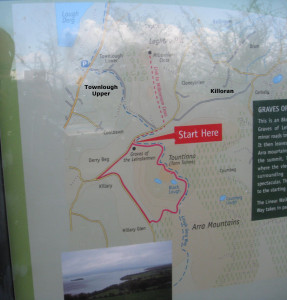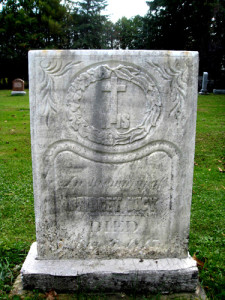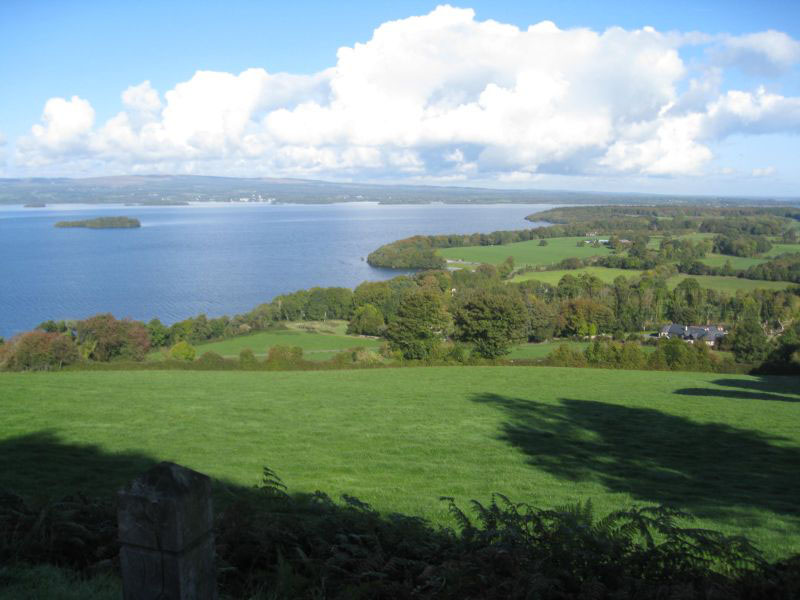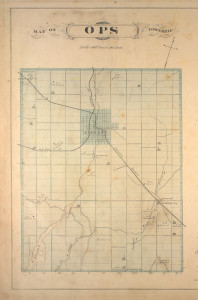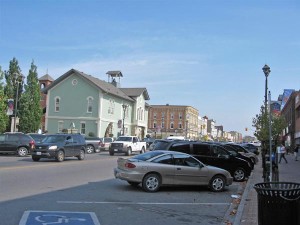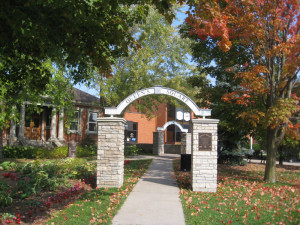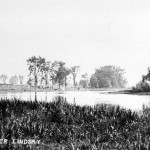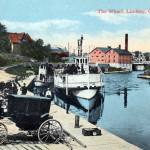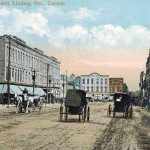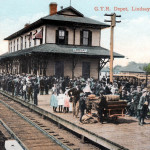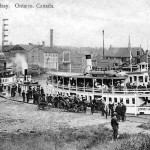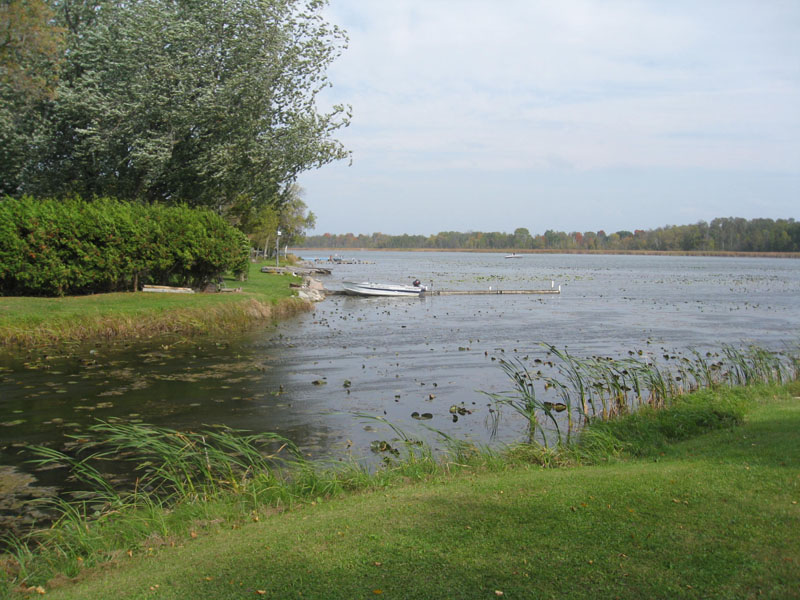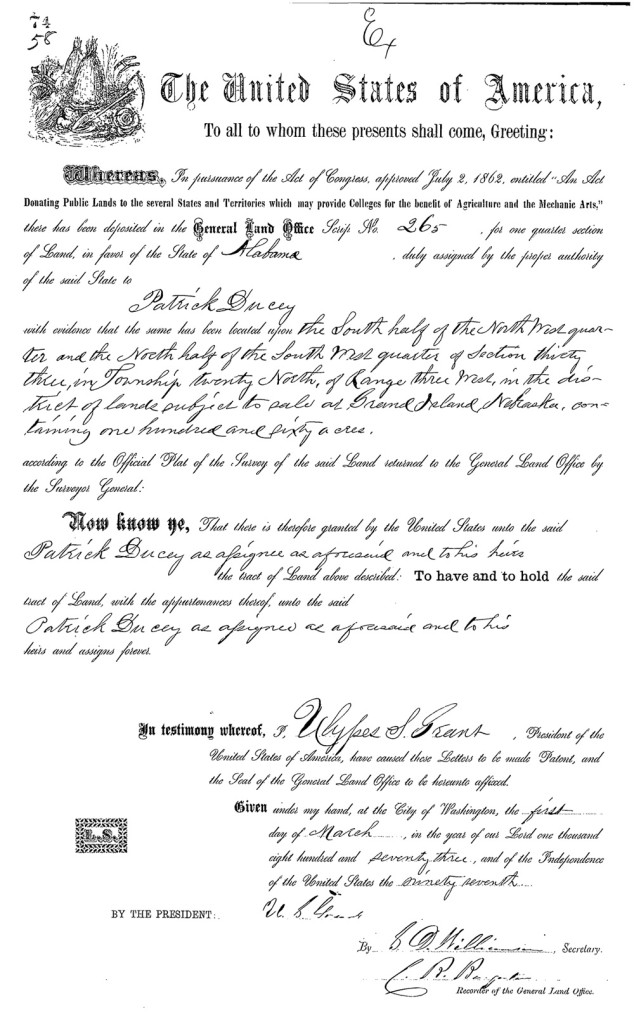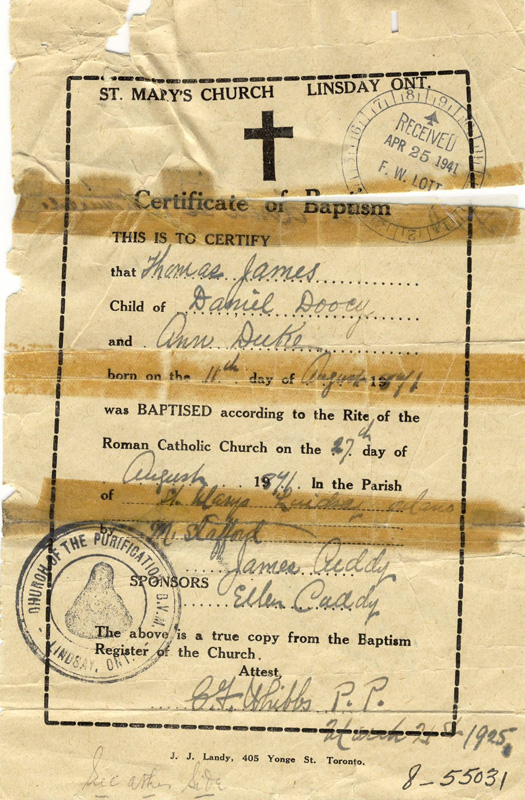This website is dedicated to the memory of the man who got it started – Gerald E. Ducey, who passed away on Christmas Night, 2012, at Cupertino CA. Gerry had been searching his family history for several years and by 1998 had drawn many of our extended family into his passion, that of finding out more about the origins of his branch of the Ducey family. This branch is descended from Daniel Ducey, the second of seven children born in Ireland to John Ducey and Bridget Brohan. The parents, along with oldest son Michael are, buried at Lindsay, Ontario. Daniel and four of the other five children are buried at Lindsay, Nebraska. (More about contributors to this project at the end of the website.)
1.0 What this paper is about.
John Ducey and Bridget Brohan are believed to have come to Ontario with six of their seven children about 1846-47 from Tipperary Co., Ireland, during the start of “the Great Irish Famine”. With my American Ducey cousins, we are trying to determine precisely where they came from in Tipperary and exactly when they arrived in Canada. The project does not deal with subsequent generations in any detail. I leave that for others.
1.1 Duceys in Ireland.
Not a common Irish name, Ducey derives from the Norman town of Ducey, France. The earliest that the name has been found in Ireland is in 1625 and could have arrived there during the Norman invasions of the Southwestern Irish coast in 1169 and again in 1171. A second arrival theory involves the family of a Norman Ducey invader in the service of Queen Isabella, who arrived in England about 1326-27. He was given substantial land in Gloucestershire for his service. A descendant of this Norman Ducey could have come to Ireland by the early 1600’s, either for trade or English occupation. One of his many descendants was Sir Robert Ducie, who amassed a business fortune and was described as banker to King Charles, who made him a Baronet in 1629 and appointed him for a term as Lord Mayor of London in 1631.
Despite scant documentation, some Ducey families are found in Ireland of the 1700’s. By the early 1800’s, several inhabited the counties of Waterford and Tipperary with a few found in Limerick, Cork, Clare and Mayo, as well as some Protestant Ducey families in Norther Ireland.
My personal theory of how the French name of Ducey got to Ireland is the earliest one, that the first Ducey arrived in Ireland during the Norman Invasions along the southwestern Irish coast in 1169 and again in 1171. The distance from coastal Waterford to Nenagh, Tipperary is only 100 miles. For whatever reason, Ducey descendants could easily migrate north over the 500 years before we discover the first recorded Ducey living in North Tipperary in 1665.
A John Ducey, listed in the Hearth Money Records of 1665-7 as farming at Lahardan, near Two-Mile Borris, is the earliest Tipperary Ducey yet found. It is conceivable that our 19th Century Tipperary Duceys are descended from this man. It is noteworthy that this man’s name carried the French spelling, “Ducey”‘ at that time. (SN 1.1_1)
For more about these early Duceys see the Irish section of this website : www.duceysfromducey.com.
We only find a single other Ducey in Tipperary before the 1820s when the Tithe Applotments were recorded. This one was Rd. Doosey, identified as a “papist” residing in the parish of Clanbollogue, during the 1776 Religious Census of Ireland. (SN 1.1_2)
1.2 In the mid-1840s, our John “Doosey” was not the only one of that name living in North Tipperary!
Complicating the difficult task of trying to find Irish records from the period of 1800 – 1845, is that our John Ducey was an illiterate tenant farmer who may have had no idea whether his last name was spelled as Ducy, Ducey or Doosey, all versions of the name appearing on early land records. (Doosey seems to be the phonetic choice by property valuators in the early 1840’s.) The only place in Ireland where we find our John” Doosey” is at what we believe to be a temporary, and his final Irish location, before leaving for Canada, either in the Fall of 1846 or the Spring of 1847.
Our research leads us to believe that before leaving Ireland, the family lived on a five acre plot of land on the townland of Townlough Upper, in the civil parish of Castletown Arra, North Tipperary. The closest town was and remains Portroe, in the Catholic parish of Portroe. It is about eight miles north-west of Nenagh and close to the Shannon River – Lough Derg waterway.
At the time we believe he left Tipperary for Canada, at least three other John Ducy/Doosey families were recorded as living in North Tipperary, with another just south at Ardagh, Co. Cork. Two of the Tipperary John Duceys lived within a few miles of ours, one at Garrykennedy, the other at Birdhill, with the third near the town of Thurles. Records of each of these families show they remained in the same Tipperary locations well after any further traces of our John Doosey disappeared from North Tipperary. (SN 1.2. _1)
At the same time, other John Duceys were recorded as living in the neighboring counties of Limerick and Waterford. Several generations of a John Ducey family, along with those of his two brothers, farmed just north of Dungarvan, Waterford, County, at Coolbegan East, Templemichael Parish, from the late 1700s to the early 20th Century. One is reminded that John, as well as Patrick, and Michael, were among the most common forenames of Irish Catholic men in the early 19th century, making it more difficult to identify one John from another.
We do not believe that Townlough Upper was our John Ducey’s ancestral home, but rather that he and his family arrived there from elsewhere in Tipperary, simply out of economic necessity. However they could have come from as far away as Waterford or from across the Shannon River in County Clare, where a few Ducey names are also found in the early 1800s.
Local Tipperary sources believe that in the 1830-40s, most of the tenant farmers who settled on small lots at Townlough Upper, did so to work in the slate mines at nearby Killoran. There were some 122 slate quarries in south-western Ireland by the mid-19th century. They offered scarce, steady-paying jobs and attracted men from England, Wales and all over Ireland. We have been told by the North Tipperary Genealogical Centre at Nenagh that this made the Portroe area quite affluent at the time, such work providing considerable additional money in circulation. Later in the century, when the Irish slate business lost its prominence, many of these miners moved to Australia and the United States, in the latter case, into upstate New York. The KIlloran quarry was two miles away as the crow flies from Townlough Upper — an easy walk to work for a man in those days.
Adding substance to the theory that John Ducey came to Townlough Upper for such work is the fact that any farming father would be hard pressed to support a family of nine while having to pay rent on a five-acre farm.
1.3 What do we do know about the John Ducey/Bridget Brohan family?
The few pieces of fact confirming a Tipperary origin for the family come from Canada and U.S. Census reports and from obituaries of those children of John Ducey who later died in Lindsay, Nebraska. This evidence is backed up by a memoir written to me in 1959. In it, responding to a direct question, my grandfather, Thomas James Ducey, wrote that the family came from “Nenagh, Tipperary.” I believe he was referring to the general location, not the town of Nenagh itself, since this family all earned their living as farmers in North America. Nenagh served as a market town for the parish of Portroe, in which Townlough Upper was located.
My grandfather was one of Daniel Ducey’s 13 children and was born in Lindsay ON in 1871, living there on a farm until the family moved to farm in Nebraska. He never knew his is own grandfather, John Ducey, who had died in Lindsay, four years before he was born. My grandfather’s knowledge about the family origins came during his youth in Lindsay, from his “Uncle Mick,’ the eldest son Michael, admired and described by Thomas J. Ducey as “a fabulous character.” ( SN 1.3_3.).
A church record lists our John Ducey’s death at Lindsay Ontario as 07 April 1866, and puts his age “at about 80,” thus born about 1786. At present, we do not know any more about exactly when or where he was born in Ireland.
The John Ducey – Bridget Brohan Family*
DUCEY John b. circa 1786 d. 07/04/ 1866 at Lindsay ON
BROHAN, Bridget b. 1796-97 (est.) d. 06/08/1847 at Lindsay ON
Michael b. circa 1814 d. 06/04/1889 at Lindsay ON
Ellen (O’Keefe) b. 20/11/1820 d. 26/03/1891 place of death uncertain
Daniel b. circa 1821 d. 29/10/1894 at Lindsay NE
Sarah b. 02/01/1826 d. 12/11/1896 at Lindsay NE
Catherine (Moore) b. 1829 d. 10/06/1888 at Lindsay NE
James b. 15 /08/1830 d. 03/10/1907 at Lindsay NE
Patrick b. 17/03/1834 d. 02/02/1904 at Lindsay NE
*birth years on grave stones are confirmed by Canadian and U.S. census reports, except for Bridget.
We believe that Tipperary land records, circa 1845-48, identify our John “Doosey” as a tenant farmer living on Lot 31, a 5-acre piece of land, in the townland of Townlough Upper, about 8 miles W.N.W. of Nenagh. An Irish ‘townland’ was the country’s smallest geographic division. It could be as small as one street or as large as hundreds of acres. There are some 3,245 townlands in Tipperary alone but today they no longer serve as a geographic or statistical function for land valuation. However they remain a valuable historic indicator.
In 1845 – 1846, Townlough Upper was composed of 34 or 35 lots, divided among an area of 327 acres. rising from low, lush farmland to a centering hill along the Arra Mountains. Almost all lots contained what was described as a 2nd or 3rd class dwelling, basically a one-storey mud-walled structure. It was within the civil parish of Castletown Arra, today referred to as Castletownarra. The Roman Catholic parish at that time was Portroe, in the Catholic diocese of Killaloe. The closest villages to Townlough Upper then, as now, were Portroe, GarryKennedy, Newport and just to the south at Ballina. Irish tenant farmers paid rent based on land taxes, to the actual landowners, most of whom were wealthy British families or Irish aristocrats.
Land records, in Irish Rate and Valuation Books of the era, also indicate that this John “Doosey” and his family had left their rented property by late August, 1846. After that ,the earliest evidence of these Duceys in Canada comes from Bridget ” Ducy.” A small but modestly ornate gravestone with her name and date of death in August 1847 is still found in the Catholic cemetery at Lindsay, Ontario.
Oral family history from my grandfather tells us that John, wife Bridget and six children were preceded to Canada by eldest son Michael. This is a common pattern found among early Irish emigrant families.
Usually the eldest or strongest son was sent out first, to gain a foothold – a job, or some land – in North America, Australia or elsewhere. Money was then saved at both home and abroad to pay for later passage for the rest of the family. My grandfather was told by Michael that the latter came to Canada about seven years before the rest of his Ducey family.
If so, the 1847 date on the gravestone of “Bridget Ducey,” leads us to assume that Michael, then about age 26, came to Canada about 1840. However, extensive searching of ships’ passenger lists and emigration and immigration records of the period have failed to find any evidence of Michael’s move to Canada or that of his family some seven years later. We have not been able to find any land records showing Michael in Canada until 1851, but will provide an explanation about this point later. Nor can we match up any neighbors from Townlough Upper who may also have come to Lindsay Ontario during the period when Michael left.
While the parents died and were buried in Lindsay, Ontario, five of Michael’s six siblings and their families would leave Canada between 1871-86, along with a handful of Irish neighbors, moving to Platte County, Nebraska. They went there to claim-stake larger farm homesteads. The earliest of these settlers, which included brothers Patrick in 1871 and James in 1872, named their new Nebraska town Lindsay, after their first Ontario home. Brother Daniel and his family arrived there in 1886-87. Sisters Sarah and Catherine are found living there with brother Patrick in the 1880 U.S. Census. No firm trace of eldest sister Ellen’s final location has yet been found.
2.1 Bridget Brohan.
The only certain record we have about the earthly existence of Bridget Brohan Ducey is found at her gravestone in Lindsay, Ontario. We have not found any solid trace of her life in Ireland. Given that the eldest son, Michael, was born about 1814, we guess that she was probably born circa 1792-1800, and may have married about 1812-1814.
Colleague Marty Krauter has come across an intriguing find among the recently released Irish parish records. Searching the Nenagh Parish records, he has found the 1795 baptism of a Bridget Broughan, daughter of Michael and Honora Broughan. As we have often seen, the written record of early Irish births, marriages, and deaths is usually spelled phonetically by choice of the priest involved. This birth year closely matches that listed for our John Ducey, namely 1796. That would make the two about the same age, and living in the same area, Nenagh. Broughan is a common variation of the name Brohan, or vice-versa. In fact there are both Broughans and Brohans living in the Nenagh area today. There is no further trace of this Michael and Honora Broughan but there are several other Broughans listed in Tipperary land records between 1814 and 1841.
A marriage record from Cahir, Tipperary, lists a John Ducy marrying a Bridget Ducy(sic) there on Feb 2, 1809. No parents of either are listed on the record but the witnesses were Denis Flaherty and Bridget Ryan, the priest, John Burke. The date and the names are a close fit, if the priest made a clerical error about her last name. However this record lacks enough evidence to draw any conclusions and no further Ducy clues have been found at Cahir. (SN 2.1_1)
Supporting the Ducey-Brohan link are land records that show several Brohans living in North Tipperary, about the same time as our John Ducy. These records include James Brohan, on tax and land records at Garrykennedy in 1824 and at nearby Inchamore, Templeleachally civil parish, in 1826; Margaret Elizabeth Brohan at Portroe in 1850, and Phillip Brohan, at the wedding of his son, Edward Brohan at Portroe in 1869. As well, eight young Brohans and some young Duceys (all mainly orphans) are also listed on an Australian web site as leaving that part of Tipperary for Australia between 1845 and 1865. (SN 2.1_2)
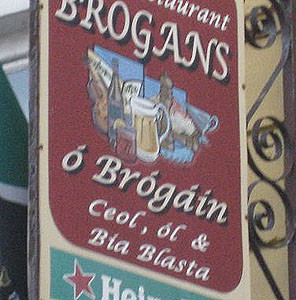 So Duceys and Brohans lived in close proximity, lending credence to the marriage of John and Bridget, even without records. Unfortunately, making our task most difficult, we are told that neither marriage or baptismal records exist for Portroe Parish before 1849, three years after our family had been gone. Today the Brohan name is still found in Nenagh and at nearby Ennis, County Clare, just across the river from Ballina. As well, Duceys still live in Tipperary and Waterford today.
So Duceys and Brohans lived in close proximity, lending credence to the marriage of John and Bridget, even without records. Unfortunately, making our task most difficult, we are told that neither marriage or baptismal records exist for Portroe Parish before 1849, three years after our family had been gone. Today the Brohan name is still found in Nenagh and at nearby Ennis, County Clare, just across the river from Ballina. As well, Duceys still live in Tipperary and Waterford today.
A photograph taken in 1993 by Jack Ducey, of Jacksonville, Oregon, at St. Mary’s Roman Catholic Cemetery in Lindsay ON, shows a gravestone that reads, “In Memory of Bridget Ducy, died Aug 6 1847”. No written record of her death at Lindsay has been found. However, she is referred to as “deceased” in subsequent marriage records of her children. For example, at the marriage of son Daniel in 1856, the reference is “Daniel Ducey, son of John Ducy and Bridget Broghan, deceased, of the Township of Ops…” Lending credence to the belief that her place of death was indeed at Lindsay, her name does not appear on a list of those who died in North Tipperary during the summer of 1847. SN 2.1_3)
Assuming that the family left Townlough Upper and Ireland in the Fall of 1846 or Spring 1847, she was probably about age 49-50 when they came to Canada. Her date of death is close to the peak period of Irish suffering. The year 1847 is marked by potato blight, famine and typhus, along with hundreds of emigrant deaths at sea from among the growing fleet of ships then sailing the arduous passage to North America . She is not found among those Irish names listing the 5,000 immigrants buried at the quarantine station of Grosse Isle, Quebec. Most perished there from typhus fever, others during the voyage to Quebec in1847. With 100,000 Irish emigrants to deal with at Grosse Isle that year, many who appeared healthy were given only a perfunctory check and allowed to continue on, subsequently dying of the fever after arrival in British North America. We believe that Bridget Brohan-Ducy was among this latter group. (SN2. 1_4)
In early records at Lindsay’s St. Mary’s church, her name was initially spelled as “Broghan.” But the same priest who entered the records there for many years, Fr. James Farrelly, later spelled it as “Brohan,” about the same time that “Ducy,” in both Lindsay and Canada census records, began to be spelled as “Ducey”. Few immigrants came to church in this period with personal documents, especially with no passport needed to get from Ireland to Canada. Fr. Farrelly’s records show he was a phonetic speller, i.e. Keefe became Kief, Ducey became Ducy.etc., in his early records.
Bridget’s second child, Ellen, was born 6 years after Michael in 1820, followed by son Daniel in 1821. There was another gap of 5 years before the birth of Sarah in 1826. These two gaps suggest other children may have died at childbirth or in infancy, a distinct possibility given the times and the circumstances in rural Ireland. Her seventh and last child, Patrick, once an adult, claimed to be born March 17, 1834, making him a child of 12 when the family left for Canada. (With few birth dates written down in tenant homes during this era, St. Patrick’s Day was often later picked as a memorable mid-March birth date.) No Irish baptism records have yet been found for any of the children.
2.2 John “Doosey” of Townlough Upper.
According to cartographer Samuel Lewis in 1837, the civil parish of Castletown Arra covered 6697 acres and contained 4110 inhabitants. It was situated close along the east bank of the River Shannon/Lough Derg and the road from Nenagh to Killaloe was its main north-south artery. About 720 acres were mountainous and “the remainder good arable and pasture land.” It had a constabulary police station in the area and local fairs, chiefly for cattle, sheep, and pigs, were held four times during the farming season. There was an ancient Roman Catholic church at Portroe and a parochial school which in 1837 was attended by about 50 boys and 30 girls. There were four “seats,” or aristocratic land holdings, usually each with a stately stone house. These were serviced by a chapel at Portroe for “that of the Established Church,” (The Church of Ireland) and included a pay school for about 120 boys and 30 girls in 1837. (SN 2.2_1)
A rare summary page existing from the Irish Census of 1861 reveals that in 1841, Townlough Upper had a population of 172 persons with 33 houses on its 35 tenant lots. Ten years later, at the peak of the famine, the population had been reduced to 98 people and 17 houses, reflecting what occurred throughout Ireland. (SN 2. 2._2)
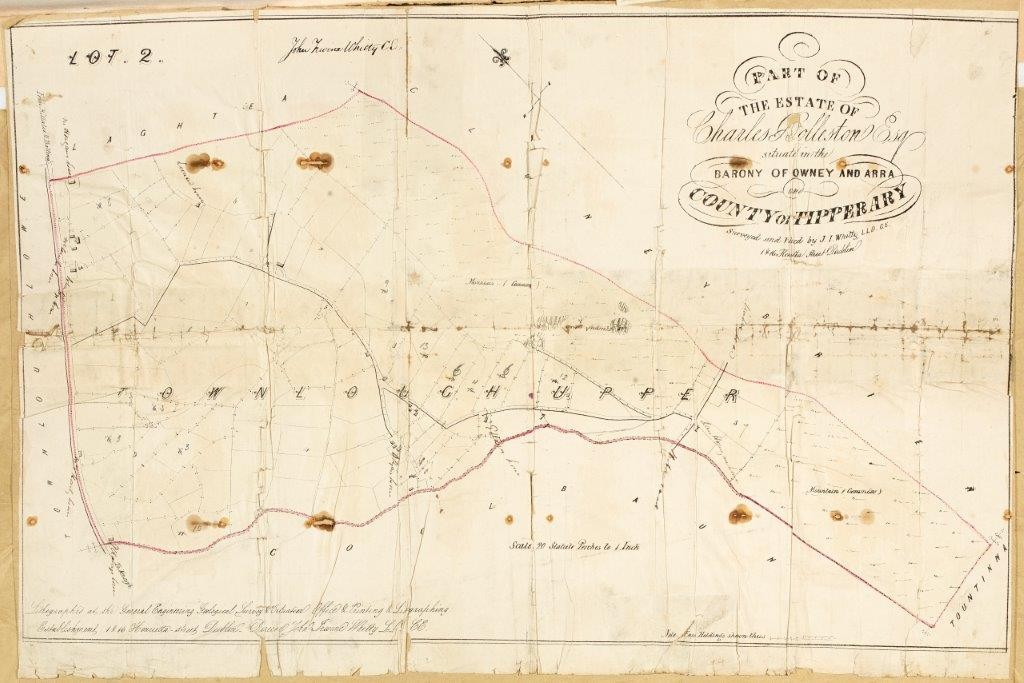
Source: National Library of Ireland. This 1854 map shows the townland of Townlough Upper, outlined in red. Click on photo for enlargement.
Today there is only a handful of modern bungalows to be seen among the lush, green fields of Townlough Upper.
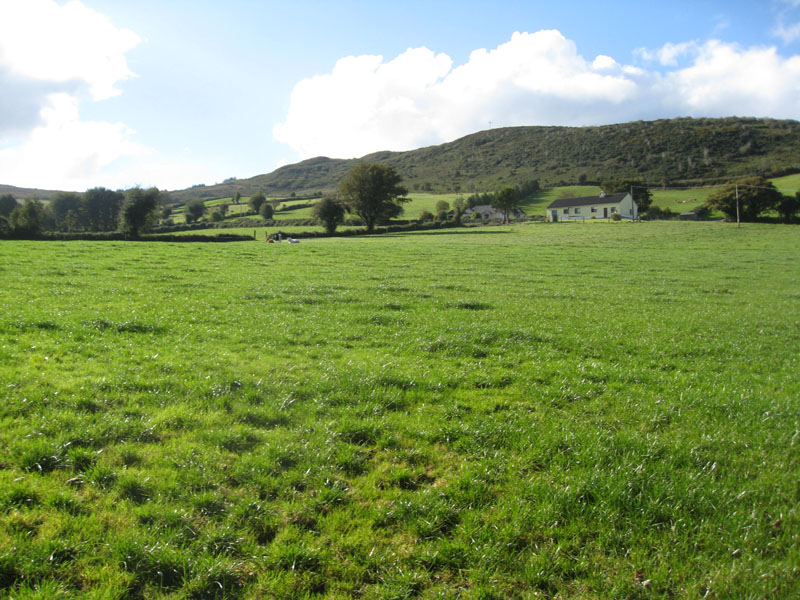
Townlough Upper today, looking from the East toward its summit.
Because only a few fragments of Irish Census records survive before 1911, genealogists now have to work with what still exists of various Irish land records. Among the major census substitutes are the Tithe Applotment Records of 1823-38, which listed most land owners and many, but only an estimated 40 per cent of their tenants, as well as the very extensive Griffiths Records of Land Valuations, done between 1848 – 53. Our John ”Doosey“ does not show up among the few tenant names in the Tithe Applotment records for Townlough Upper. Evidence suggests he was gone just before the Griffith Valuations were done.
However two land records, referred to as “rate books,” have been unearthed by Marty Krauter of Beaverton, Oregon. His wife Kathleen is a descendant of the Garrykennedy John Ducey and Marty searched through the Castletown Arra rate books, seeking John Duceys of the mid-1840s. During his quest, he found that John “Doosey,” a North Tipperary tenant farmer, had occupied a rental lot and dwelling on the townland of Townlough Upper until the late summer of 1846 and then disappeared.
The first book is a Valuation Office Field Book, an official document required by the British Parliament to keep track of Irish lands for taxation purposes. This one, (FHL#2358276) is a summary of the townlands held in the civil parishes of Castletownarra and Templeachally, in the Baroney of Owny and Arra. It contains no specific dates for each set of listings but indicates that it was compiled over a period between 1845 and 1848. In the case of Townlough Upper, located in Castletownarra civil parish, the lot numbers from 1 – 34 appear written in numerical order. “John Doosey” is listed as the tenant on Lot 31.
Included in hand-written notes are the names of the lot “Occupiers,” the immediate “Lessor,”, in this case, Sir Francis Rolleston, and a description of the tenement and the contents of each farm. (SN 2.2._3)
The second official land record, that of a House Book, (FHL#2355293) also identifies “John Doosey” as the occupier of Lot 31, at Townlough Upper, paying his rent to his immediate lessor, who by then was the widow of Sir Francis Rolleston. The “Description of the Tenement” is described as “House and Land,” and the “Contents of Farm” are listed as 3 – 1 – 2, with annual rent at “10/ 0.” I have yet to determine if this is stated in British pounds and pence, but it seems pretty high, given the assessed value of the lot mentioned below. Rents of other lots in this townland ranged from 8/0 and 9/0 up to 25/0. Some of the lots were as large as 15 acres. The 5-acre Doosey lot is described as 1.6 as acres wide, by 3.0 acres long. It contains the standard description of a “dwelling and land.” This particular lot had an assessed value of 7.1 British pounds. SN 2. 2._4)
The House Book, was obviously carried out by an assessor on the ground who walked the property because the lots are listed by their geographic order rather than numerical order. Today, as can be seen on Google Earth, a somewhat larger Townlough Upper than that shown on an 1823-28 map has a shape close to that of a bent rectangle, positioned roughly North to South, parallel to what is today Road No. 494. At one corner were the lots 3, 2, 1 and 8. A the far opposite corner were the lots 29, 31, 32, 33 and 34.
By comparing details in the two books, we conclude that as far as Townlough Upper is concerned, the Field Book was compiled before the House Book. We believe so because the latter indicates John Doosey’s departure in August 1846. Moreover, the lessor in this Field Book is Sir Francis Rolleston while the House Book lessor is his widow, Helena Rolleston. The House Book shows that it was calculated by “G. Sutcliffe 21 September” with no year indicated. However, a few pages later, dealing with another townland, the book contains this notation: “22 August 46 Calculated b C. Peardon.” The 46 indicating the year as 1846.
In the House Book, the name “John Doosey” is crossed out and that of “Daniel Hourigan” is written over it. Similarly, the names of his immediate neighbors on lots 29, M. Keogh, and that of Mary Mahar, lot 32, are also scratched out, indicating they too had left their lots by late August, 1846. Tenants had various reasons for leaving their lots during this period, however a large number were forced off the land by the owners.
Daniel Hourigan was already listed as farming half of lot 13. Michael Hourigan farmed lot 3. while Martin Hourigan occupied lot 27. Bridget Hourigan was listed on half of lot 11. Descendants of these Hourigans were still living at Townlough Upper as late as 1911. I believe that at one time or another, the Hourigan family was connected to the local slate company, about 2 miles distant.
In the 1840s, the quarry was run by the Imperial Slate Company. Slate roofing tiles are still produced there today by the Killoran Slate Company, which is known for restoring slate roofs on historic and stately buildings in the British Isles.
However, returning to the Field Book, on the page preceding John Doosey’s enumeration, the evaluator wrote the following note: “The Imperial Slate Company took lots 19 & 31 from the landlord but the occupiers will now pay to the landlord.” What this infers is not quite clear because ownership of the lot continued with the landlord, in this case Mrs. Helena Rolleston. It could mean that the slate company was allowed to put its own workers in those abandoned lots.
The Imperial Slate Company, at nearby Killoran, was then “big business” in North Tipperary and apparently expanding. Slate mined from the Arra Mountains was hauled to the Lough Derg/ River Shannon waterway for shipment to Dublin and England where it adorned fine homes and castle roofs.
However during the mid-1840s, the company itself had become very unpopular among some employees and local residents, making it a target of violence as Irish society began to break down under famine conditions. (SN 2.2._5).
This change of Lot 31 control from the Rolleston family to the Imperial Slate Company prior to August of 1846 could have been the trigger for John Doosey’s decision to move his family to Canada. Or it could simply have been noted on the page after John Doosey had already left of his own volition. Helena Rolleston continued to own the property until the family was forced to put it up for sale in 1854.
Obviously, the worsening situation in Ireland must have been the main influence on John Doosey’s decision to leave. Potatoes had by then become the diet staple among most Irish families. Rural families were not spared as their grain crops had to be exported to England. Despite record crops in Western Ireland in 1844, a potato blight that briefly broke out in 1845 had resurfaced with a vengeance just before harvest in July 1846. It would quickly cause disease, starvation and a strong upturn in Irish emigration by the Fall of 1846. And where else would this 60 year-old tenant farmer with a wife and six children go, but to join son Michael in Ontario, British North America? (SN 2.2. _6)
Despite wages at the Imperial Slate Company, living conditions in North Tipperary were quickly worsening and local crime was prevalent. Like many Irish of his day, the painful decision to leave Ireland offered the only chance for a better future for a large family whose his eldest son had become established in North America. The year 1846 marked the start of the Irish Famine years. (SN 2.2._7)
This John Doosey’s name does not re-appear anywhere else in North Tipperary after he leaves Lot 31, thus supporting the concept of his emigration, either in the Fall of 1846 or the Spring shipping season of 1847. We must assume from her gravestone that his wife died at Lindsay, Ontario in August of 1847. The three other John Doosey families recorded in North Tipperary at the time continue to appear in place for at least another 20 years or more according to later Irish records.
2.3 Why would tenant farmer John Doosy leave Tipperary in 1846 and emigrate with a wife and six children to Lindsay, Ontario, Canada?
To get an understanding of the situation in Ireland about 1845, following are some brief excerpts from the booklet “Nenagh and Its Neighborhood,” published by E.H. Sheehan in 1976. It is an anecdotal history assembled from 19th century newspaper articles and various official records relating to Nenagh and the surrounding area. It is not well documented but it offers a realistic glimpse of what was going on there at the time.
“……The Famine Years in Nenagh and District
“Amidst the horrors of Black Forty-Seven,’ says A. M. Sullivan, in his Story of Ireland, ‘the reason of strong men gave way. The people lay dead in hundreds on the highways and the fields. The corn exported from Ireland that year would alone, it is computed, have suffered to feed a larger population. The Irish peasantry in those days was enduring all the pangs of famine or the humiliations of outdoor pauper life. Coming near home it can be seen that the fertile plains of Tipperary did not escape the dread visitation of famine and pestilence. The present writer will endeavor to convey a vivid description of the events which were associated with this unhappy period.
“December, 1846 – There are 2200 totally destitute persons in Nenagh, of whom 700 are widows, orphans and infirm. A soup-kitchen has been opened in that town at which hundreds of the poor are supplied gratuitously, while those able to pay are charged 1d. the quart.
“1847 – February – The progress of the famine is fearful. Traces of death appear in the countenances of the aged and the young.
“March – There are 1500 paupers in Nenagh Workhouse and upwards of 1,000 families are daily relieved at the soup-kitchens, while the cultivation of the soil is still most totally neglected.
“June – At Nenagh fair, a most extraordinary exhibition were a few cartloads of coffins, which, strange to add, met with a brisk sale….. In Nenagh Union the black-sodden rye bread, the poor dying by the roadside, in the streets; the coffins sold at the market-cross, the famine-stricken woman dead and five children by her side in the market house of Nenagh where the death rate in the Workhouse by fever and famine was 200 a week…..”
These were the conditions in Tipperary and elsewhere as the John Doosey family left Townlough Upper and Ireland behind. The situation would only get worse over the next few years. SN 2.3._1)
Well before the 1840s, both Canada and the United States were actively courting immigration from Ireland. One million of Ireland’s poor Irish died during the famine years with another three million Irish leaving their country by 1900. In sum, the Irish population had been reduced by half.
Canada, in what was then called British North America, offered seamless access to citizens of the British Empire — no change of country required and it then had the same British monetary regime. At the time it also offered a cheaper fare than sailing to New York. That soon changed and by 1847, the increased flow of Irish emigrants brought cheaper fares to New York, Boston, and other U.S. ports, making America the more popular destination for the balance of the century. (SN 2.3. _2)
Many Canada-bound immigrants “got off the boat” at long-established Irish fishing areas of Newfoundland, Nova Scotia and New Brunswick, most of these settling along the coastal regions. For those heading to Lower Canada (Quebec) or Upper Canada (Ontario and the West), the ocean sailing destination was the port of Quebec City, on the St. Lawrence River. Some would remain in French Canada. Others would cross the nearby U.S. border into Vermont or New York State. In the Canada of the mid-1840s, the majority would continue westward by steamboat up the river to Montreal and then on to Ontario by boat or wagon, in search of a living wage or affordable land.
For those leaving northwest Tipperary, the town of Limerick in County Limerick, just across the Shannon River, was the closest ocean port, offering cheap fares and thus a natural emigration choice. Ship owners, most notably such as Francis Spaight, an Irish timber merchant, landowner and magistrate, began a profitable shipping business out of Limerick, carrying immigrant families to Quebec City and importing Canadian lumber back to the British Isles on the return trip. The Spaight family had a Tipperary residence at Derry Castle, a short distance from Townlough Upper. So at that time, he and his shipping business would be well known to local residents such as John “Doosey”. SN 2.3_2)
There were two types of emigrants then sailing to North America. Most were small farm owners or tenant farmers who either could or could not, save up for the fare of three British pounds per head over time. The second were farm tenants, paupers and indigents that some land owners, including Spaight, wanted to clear off their land to improve profitability. This second group were provided with two pounds of food per day during the voyage under a British Act of Parliament, while the first group had to pay for their own food.
From tenants on his own land, Spaight only took entire families to Canada so that he could clear the land and establish larger, more productive farms. While not on Spaight’s land, John Doosey would naturally take his entire family, whether forced to or not.
Nonetheless, some land owners truly wanted to give their tenants relief and a new start in “the Americas.” Several paid for their tenants’ passage with some also providing settlement money.
The overall demand for ocean transport was far more than there were ships to carry those wanting to go. Between 1842-47, the lumber ships of Francis Spaight alone were able to provide the Port of Limerick with emigrant numbers totaling more than 20,000 by June, 1847.
It is probable that Michael Ducey also took this route about 1840, followed by his family seven years later. Unfortunately, while some Limerick sailings provided passenger numbers, few passenger name lists exist. Even the scattered passenger lists that do survive from the larger British and Irish ports, such as Liverpool, Cork and Waterford, are hit and miss, and are not considered as fully reliable sources.
There is no trace of Michael Ducey’s earlier voyage, nor that of a John Doosey family of eight about 1846-47. Nor is the family found in existing records of St. Lawrence River steamships that ferried new arrivals from Quebec to Montreal.
We will never know if there was a deliberate exit plan between John Ducey and his eldest son. Michael’s earlier departure could have resulted from a young man’s sense of adventure, coupled with frustration at the life he and his family were living. Perhaps Michael left with a young neighbor friend or two. As was often the case, the Duceys may have known of a neighbor or a family that had already left and found a better place in Canada. However as yet, we cannot find a conclusive match between surnames listed at Townlough Upper in 1846 with Irish names showing up as close friends of the Duceys in Lindsay, Ontario. Nevertheless, some reason or some person, influenced Michael Ducey to find his way into the forested interior area near Lindsay, Ontario and make it his ultimate destination about 1840.
2.4 What do we know about the Lindsay area of Ontario in the 1840s?
The Lindsay area was not a place that a wandering immigrant would just stumble across in the early 1840s. Free land in Quebec was fast filling up with Irish emigrants. But eastern Ontario had now become known to immigrants as a place to find both work and land. Victoria County and Ops Township had been surveyed by 1828 and Irish settlers began arriving in the area about the same time. SN 2.4._1)
What would later become the town of Lindsay lay in a forest some 200 miles south-west from Montreal. Once past the Lachine Rapids on the St. Lawrence River just east of Montreal, the trip required water travel , usually by a flat-bottomed boat, and later by steamer, along the North Shore of Lake Ontario, then by wagon some 55 miles north from lake-front towns, such as Coburg and Port Hope, taking another five days of travel through the interior. By the 1840s, this part of Ontario had replaced the forests of Quebec as the most popular destination for young men seeking to find work clearing land for agriculture.
Today Lindsay is an attractive and modern town of some 20,000, located along the Scugog River and the center of a large, productive agricultural economy. But in the 1840s, it was well off the beaten water route between Montreal and Toronto (then York) and was just the establishing itself on the western edge of that part of the Canadian frontier.
Irish settlers began arriving in the area in the early 1820s. In 1821 the government of Upper Canada offered 4,000 square miles of virgin land for sale in the area. Some 1100 square miles of that was in the Lindsay/Ops Township area. Most of it required timber to be harvested to get to the ultimate objective, fertile agricultural land. Lindsay, within Ops Township, was the seat for Victoria County. By 1845, what would become the town of Lindsay had two schools and a Roman Catholic church, the latter to serve a rapidly growing Irish Catholic population. (SN 2.4._2)
Ops Township, composed of 62,000 acres, was one of three adjoining townships where the earliest settlers sought land for farming. In 1823 land agent Peter Robinson brought 142 Irish families, largely from Cork, into the area of Emly Township, just adjacent to Ops Township. (SN 2.4._2) A very few of those came from Tipperary and settled in Ops Township but do not show up in our Lindsay research.
More relevant among early settlers’ names of interest to us in Lindsay are Connell, Reynolds, Lynch and Hogan. Lindsay history identifies William Reynolds, born in Tipperary in 1811, as settling on 200 acres in south-west Ops as early as 1831. He is described as a farmer and former postmaster for the hamlet of Valentia, named after Valentia, Co. Kerry, Ireland. This is where Michael Ducy would settle, with his postal address as Valentia rather than Lindsay. As close neighbors, their proximity may have been more than just a coincidence. Their ages are also very close. However no trace of this William Reynolds has yet been found in existing Irish records, but he represents an early Tipperary link with Ops Township. (SN 2.4._3)
The only names found duplicated in both Townlough Upper of 1846 and early Ops Township are those of a Hogan family and the name Pat Clancy. A William Hogan is listed on Lot 16 in the 1846 House Book. But he was not listed in the earlier Field Book. The Canada Census of 1861 lists John Hogan of Ops as born in Ireland in 1799, and Patrick Hogan of Ops as born in Ireland in 1835. A Michael Hogan was baptized at St. Mary’s Church, Lindsay, in February 1847. At Townlough Upper in 1846, a Pat Clancy farmed a small part of Lot 5. A Clancy descendant stilled lived there according the Irish census of 1911. Both Hogan and Clancy were very common Irish names found on both sides of the Atlantic so any connection may have been just coincidence. We have been unable to link them with any connections to the Lindsay Duceys, such as a witness at a marriage or a birth, or as neighbors along Concession Roads 2 and 3 west of the Scugog River. No further Irish trace is found of William Hogan at Townlough Upper. However the name remains a slender Tipperary thread.
Ontario provincial archives state that the first land grants in Ops were to Irish brothers Patrick and John Connell, in 1825. Patrick had obtained so much land he was known as “King” Connell. Michael Ducey developed close connections with both Connells. All three had land about 6 miles south-west of Lindsay, on the west side of the Scugog River. Michael’s youngest brother, Patrick, settled there as well, on Concession Road 2, Lot 7. Another close neighbor was John Lynch at Concession 2, Lot 9. (SN 2.4._4)
LINDSAY, ONTARIO in earlier days, circa. 1890-1910
Click on images enlargement
2.5 Michael Ducey
We have no information about the Irish life of the eldest son of John and Bridget. What we know about his Irish birth is based on Canada census records of 1861-71-81. They list his birthplace as ” Ireland,” in 1814. His death record at Lindsay on April 6 1889 gives his age as 76 years. As the first-born, and without a sibling until his sister Ellen was born 6 years later, his youth would be spent helping his father on their 5-acre farm as the family grew to nine by 1834. On the other hand, by the time the last child, Patrick, was born in 1834, Michael would be age 21 and perhaps also working at the slate quarry. If so, he could have worked there for six years and decided mining was not for him!
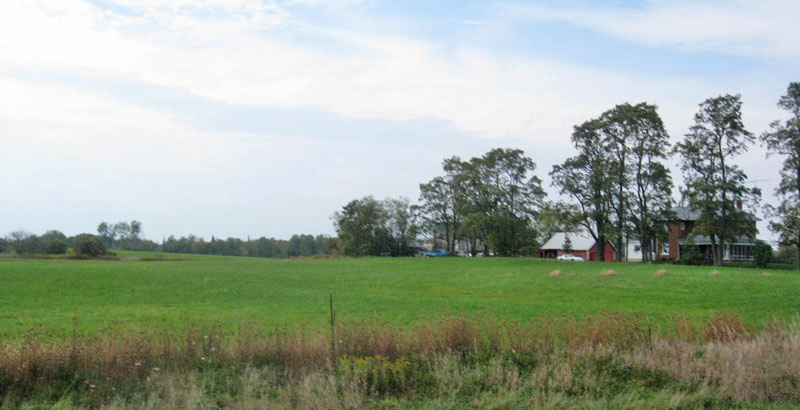
This large farm and the current house amid the trees to the right, could be part of the original property of Michael Ducey, south-west of Lindsay from 1851-1889.
Michael, or his father, may have known of a neighbor who settled near Lindsay as Irish emigration to the area began to grow quickly in the 1820s. Or perhaps, upon landing in Montreal about 1840, Michael may have learned that the forests of nearby Ontario offered a newer and better chance to find work clearing the land and eventually owning some of his own.
Based on oral family history, told by Michael to my grandfather, we believe Michael came to the Lindsay area about 1840. There is no evidence to prove the exact date, or that Lindsay was his intended destination. As mentioned above, efforts to match names of former Tipperary neighbors from Townlough Upper with those settling near Lindsay have yet to suggest any solid links. The Irish had been flocking to the Lindsay area by that time and for years after would constitute the largest ethnic group in Ops Township.
Logging work and the promise of cheap and fertile land were the early attractions to Ops Township. However Michael Ducy does not appear in any Ontario land records until 1851.
2.6 Land Records relating to Michael Ducey
1840-1851 – My theory is that Michael Ducey soon met up with John Connell, who by the early 1840s, along with his brother Patrick Connell, owned plenty of what had been crown land in need of clearing, both to gain the value of the timber and to prepare the land for agriculture. I believe that Michael worked on, and lived without title, on land owned by John Connell along Concession Road No. 1 in Ops Township. He would work for Connell for some 10 years, as well as for others, until he legally became a registered land owner.
Looking at early land records for the above property, as well as and others, one can surmise that several new residents lived on the land they were clearing and had unregistered arrangements to earn their land. Legal possession of their own property was eventually gained in exchange for clearing extra land, or earning money elsewhere. Brothers Patrick and Daniel Ducey appear to have made similar arrangements, not registering ownership of some of their lands until well after they moved away from Lindsay.
1839 & 1841 -Both Patrick and John Connell are listed on the Ops Township census of 1839 and again in 1841. The Canada Census of 1851 states that records for Victoria County no longer exist
1851 – Just prior taking ownership from Connell, Michael is recorded as clearing 22 acres of land for long-time settler and neighbor Dennis Dansey, at Concession Road No. 2, Lot 8, earning two shillings per acre that he cleared. This work probably gained him enough cash, along with what he had already earned from Connell, to buy what would be his rural home for the next 38 years. (SN 2.6._1)
1851 – 24 Nov. -Michael gained legal title as the new owner of 100 acres of land from John Connell on Concession Road No. 1, Lot 3. The purchase was recorded at a value of 50 British Pounds. Connell had acquired Lot 3 from the Crown in 1828. Concession Roads run east to west and Road No. 1 is at the very south-west corner of Ops Township. The east end of Michael’s lot fronted along the west bank of the Scugog River, a desirable and scenic property. Records also show Michael and John Connell as swapping various parcels of land for several years after. One of Patrick Connell’s sons would marry one of Michael’s daughters, Mary Ducey, in 1887. (SN 2.6._2)
1852 -22 July Michael was given permission to purchase a nearby piece of land, at Concession Road 2, Lot 8. This was the Dansey property mentioned above. It was described by the land surveyor, M. Deane, as an “additional insert of land, property includes 22 acres, two roads and 36 acres of dry land for which payment can be created. All the rest of the lot is permanently covered with water. The dry soil is occupied by Michael Ducye who has cleared off all of it and in my opinion, is worth 10 shillings per acre.” He is not recorded as the legal owner of this property until 1888, a year before his death. But as noted in the following paragraph, he arranged for his youngest brother, Patrick, to acquire this small piece of land on the east bank of the Scugog. (SN 2.6._2)
1855 – 13 – December – Michael formally purchases the 22 – acre river property at Conc. 2, Lot 8.
- 7 The Lindsay Duceys of Ops Township and Platte Co. Nebraska
Michael’s brothers, Daniel, James and Patrick, would also farm properties along the Scugog River. Again, I suspect that Michael and then his brothers had very loose arrangements with Connell or others that may not be reflected in the official land purchase records of the time. However, the 1861 Agricultural Census for Ops Township shows Daniel and James each farming 100 acres of land along or close to the river and Michael listed with 70 acres at that time. For all three. their main crop in Ops Township was listed as Spring Wheat Oats, a bit of hay for their horses and an acre each of potatoes, plus other vegetables to sustain the family. (SN 2.7._1)
Their neighbors, who were some of their close friends, included the families of James Riley, John Cudahee, John Lynch, John Teevins, Morris Curtin and James Pogue, all of Irish origin.
Records show that Patrick “Ducye” only became a registered land owner in 1863, when he is listed as the owner of 22 acres of Crown land on Concession Road 2, Lot 8. His older brother Daniel later became the registered owner of the same lot in 1871 when Patrick moved to Nebraska. Three lots owned by Daniel in Ops Township were not registered until his death, in Nebraska, eight years later. (SN 2.7._2)
In Tipperary, the Ducey name had been spelled phonetically by land enumerators as “Doosey.” In Lindsay, it was spelled in church records as “Ducy” for about 10 years, with Michael’s last name also spelled in land documents as Ducye, and Ducie as well.
Once the family arrived in Canada, I believe that father John lived out his life on son Michael’s property in Ops Township. A recently discovered missing page from the 1861 Canada Census shows that living with Michael at the time were(ages listed as of next birthday) brother Patrick 21, sister Catherine 23, and his father, John, 75, the latter listed as” not able to read or write.” There is no evidence to suggest that John ever owned land in Canada. (SN 2.7._3)
1866 – John Ducey lived a far easier life in Canada for 20 years, attending the marriages of at least two of his sons. Daniel and James in 1856, as well as enjoying the birth of a few grandchildren.
On April 7, 1866, Michael and his siblings buried their father, “aged about eighty years.” His church record states that he was buried in the Catholic cemetery at Lindsay, presumably alongside his wife Bridget. (SN 2.7._3)
Unlike his wife Bridget, today no gravestone is found with his name on it, nor has one yet been found for Michael. According to the parish website, the original cemetery, formed from three pioneer cemeteries, was established in 1860. Its gravestones and remains were moved a few blocks away to the larger, current site in 1897.
1867 – At age 53, Michael married the widow of his deceased neighbor, John Lynch, senior. Catherine Teevins-Lynch, age 31, was born in Ireland. Her parents, Patrick Teevan and Rose Smith, came from Co. Cavan, Ireland. According to the Teevan family website, she had seven children fathered by John Lynch.(SN 2.7._4) By 1881, only one, Catherine Lynch, age 19, was living with she and Michael . Michael and his wife had two children, Mary, born 1869 and Bridget Agnes, born 19 Sept. 1871. My grandfather described Catherine Teevins as “a stern old lady and how she could slap you down!”
1887 – Nov. 24, Mary Ducey, daughter of Michael Ducey and Catherine “Teevins”, marries Patrick James O’Connell, son of Patrick O’Connell and Mary Doherty at Lindsay. (SN 2.7_4)
1888 -Perhaps because he was ill, Michael proceeds with formal purchase of the 22-acre river property at Concession Road No. 2, Lot 8, which he was given permission to purchase in 1852. (SN 2.7_5)
1889 – 06 April, Michael Ducey dies from “Cancer on his neck,” at age 76. His death certificate indicates he was attended by Dr. MacAlpine and the details were witnessed by John Lynch Jr., his son-in-law. Lindsay church records show that he was buried in St. Mary’s Cemetery, Lindsay on April 8, attended by Ops neighbors Daniel O’Connell and George Breen. (SN 2.7._6)
His widow, Catherine “Teevins”, lived to see the dawn of the 20th century. She was buried in St. Mary’s Cemetery, Lindsay, on April 24, 1901. Their daughter Mary, died June 28, 1942. She shares a common gravestone at St. Mary’s with her husband James Connell and their son, Joseph.
With two daughters surviving him and his siblings gone, the Ducey name disappeared in Lindsay after a near 50-year period.
2.8 Patrick Ducey. Like Michael, who was the impetus for the Ducey family move to Canada, Patrick was the one who led the move of at least four of his five siblings to Nebraska. With little to lose and no family of his own, he initially took the gamble to find better opportunity elsewhere. In 1871 he was among the John Walker group who would be the first to leave Lindsay, Ontario and move to Nebraska.
Patrick was a life-long bachelor and while he left no descendants, by his initiative he was perhaps the family’s most influential , shaping the American futures of five of his family.
He was 12 years of age when the family left Ireland and probably had only a few years of schooling, if he had any at all. In Canada, he initially lived with his father on Michael’s farm in Ops Township, where he would have grown to manhood as a farm worker. Land records show that at age 19, on June 22, 1863, he became the first registered owner of 22 acres of Crown land located on Lot 8, Concession road 2, north of Michael’s farm, but along the east bank of the Scugog River. It was a small parcel, described as “a broken lot,” and partly submerged. But as the first owner of crown land, it was free and at least he had become a land owner. (SN 2.8._1)
We suspect Patrick was the “Ducie man” described in the Lindsay Post, of Sept. 17, 1863: “We understand that at a wake in Ops on Monday evening a man named Ducie was so severely beaten that it was reported that he was dead. But we have been unable to gather the particulars for this week’s issue.”
A week later, the Sept. 24 Lindsay Post had an update: “The man name Ducie, who last week we reported as so severely beaten at a wake in Ops, has we learn, recovered.”
Neither article gave his first name so we don’t know who among the few Ducie men in Ops received the beating, but it was probably Patrick who got into a brawl at that Irish wake. He would later be described by a neighbor in Nebraska as six feet tall and fearless.
A year later, he was again in the news. This from the Lindsay Post of Nov. 4, 1864: “Serious Accident. One Patrick Ducey, while holding a steer for Daniel Shine, of Kenney’s Island, received a severe incised wound above the knee. The axe missed the animal’s head and came down with tremendous force on the unfortunate man’s leg, making a ghastly cut. Dr. Crandell, Lindsay , was immediately sent for, and we understand that his patient is doing well.”
By that time, even farmers in Ontario were taking notice of the large tracts of U.S. mid-west land available to homesteaders who would settle on surplus railway lands. The U.S. Homestead Act of 1862 offered 160 acres of free farming land to any head of household who lived on the land for five years. Nebraska was one of the states participating. Among those in Victoria County who took an interest in the opportunity was John Walker, born in Ireland about 1826-27,who had a young and growing family.
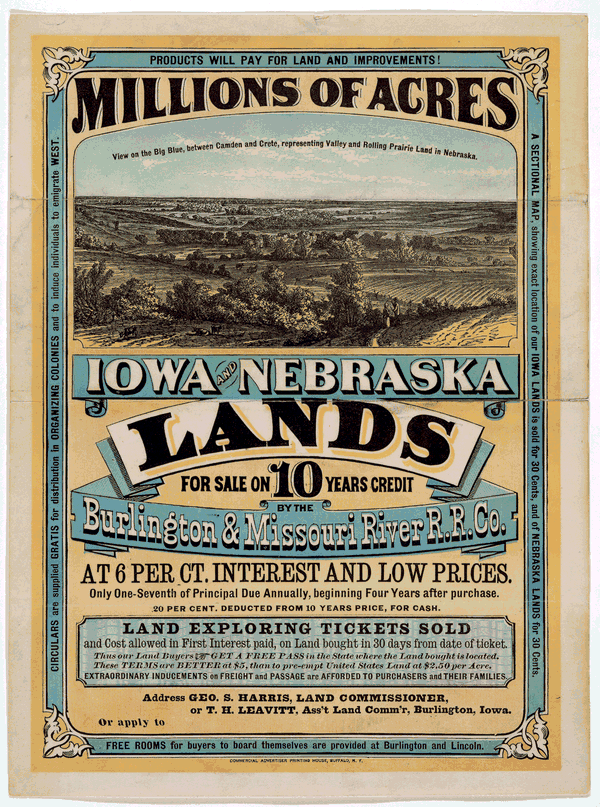
One of the many posters issued by railways to promote land sales.
Credit: Nebraska State Historical Society – Digital ID. 13401300
He decided to make the move and convinced a small handful of friends in Lindsay to join him and move to Platte County, Nebraska. With them was Patrick Ducey, ready for some new adventure and who obviously saw it as his chance to get a full-sized farm at little or no cost. He joined Walker and a few others, registering his 22 acres over to brother Daniel in June 1871. The Walker party destination was the north-east quadrant of Nebraska, in Platte County, at a place the new arrivals would call “Pleasant Valley.” Among the others who left the Lindsay area at that time was the large family of Samuel and Alice Connelly, close friends of the Duceys in Lindsay . (SN 2.8. _2)
The impetus for this immigration was the new transcontinental railway link which led to the Homestead Act in 1862. In addition to government land, to encourage construction, the railroads had been given huge tracts of land. They offered their excess properties for sale to immigrants at low or no cost. The Union Pacific Railroad received millions of acres in Nebraska and offered land for sale at very cheap prices, low taxation and up to 10 years to pay for it. Meanwhile the Federal Government offered up huge tracts under similar conditions, but at no charge if developed by residing settlers over a 5-year period. Making the area even more desirable was the quality of rich, black loam soil which offered the promise of bountiful crops to those who would farm it.
By then settlers had been flocking to the Nebraska, many from as far away as Germany and Switzerland, along with families from the eastern United States and Canada.
This caused more than a decade of tensions between the growing influx of immigrants and the Sioux and Pawnee native tribes. However with Nebraska becoming the 37th state of the Union in 1867, the era of direct conflict had largely come to an end. By 1871 most remaining Pawnees on the settlement lands had become traders with the white residents.
Some sporadic incidents took place and one of these was later described in his “colorful” memoirs by John Walker. How accurate it is may be open to question but the settler involved was Patrick Ducey!
“One day in the spring of 1871, while my son and I were engaged in breaking prairie, I saw three men on horseback coming towards me. As the neared me, they discovered I was not alone and made a sudden oblique move and sheared off in the direction of Pat Ducey’s, who was then encamped under a few boards and enjoying a bachelor’s life, and which he has clung to until the present day; as they rode towards his camp, I watched to see how they would get over the creek and when I saw them plunge into the mirey bottom, unconcerned, I knew they were Indians; they shot for Pat’s shanty on full lope and he being out breaking prairie and all alone, they dismounted in a twinkling, broke in the door and made for his larder, which contained a loaf of bread, and a few pounds of bacon, bought at the grocery of J.P. Becker.
“Pat, seeing the party approach his domicile, and fearing he might be put on short allowance, went to meet his callers; but, oh what a sight met his gaze as he crossed the threshold; enough to cause a nervous man to give up the ghost. But Patrick was made of the stuff to meet the emergency, as he saw one of the reds preparing to bag his bacon, and the other two dividing his last loaf; that was too much for a plowman to stand; there was no time to be lost if anything was to be saved, so with a bound he was on his dusky visitors inquiring in strong accents why they were robbing him of his last mouthful of food, for which inquiry, as they did not understand his dialect, he received a very unsatisfactory grunt from the one in possession of the meat, as he pointed to the bag containing it, which Pat at once seized with a powerful grip; at this danger, the other two reds came to the onset and right here commenced a tussle for the necessaries of life.
“Just imagine a six-footer of an Irishman confronting three stalwart Pawnees; and all this to protect the inner man; there was a deadly struggle and terrific were the looks and gestures exchanged in this battle for life.”
Obviously, Pat Ducey prevailed. (SN 2.8. _3)
Before long, Walker had soon acquired more than 640 acres of land, had a township named after him. His own home was the first polling place created in Pleasant Valley later in 1871. One of the poll clerks was his neighbor, Patrick Ducey, still a squatter rather than a land owner until 1873. Life for a single man was anything but easy and the first dwellings to appear usually comprised a dugout-like structure with canvas strung across poles as a roof. With few trees on the prairie, early homes were built with sod bricks. (SN 2.8._4)
Patrick encouraged his siblings in Ontario to join him as homesteaders. We have not yet been able to determine if sisters Ellen and Sarah were with the 1872 group that included brother James and wife Johanna. More about them later.
U.S. Bureau of Land Management records identify Patrick as a “patent holder” two years after his arrival in Nebraska. A Patent was a deed transferring land ownership from the U.S. Government to a settler or “buyer.”
Once an application was accepted, the buyer was announced as a ‘patent holder,’ the first step in the process to free and full ownership. On March 1, 1873, Patrick Ducey received his first Federal land grant, duly endorsed by then-President Ulysses S. Grant. It was for 160 acres of land on Section 33, located two miles south of what is now Lindsay, Nebraska. The village of Lindsay, named by Walker and its 1871 Ontario immigrants, was formally incorporated March 7, 1888.
Patrick obtained a second Federal land grant August 3, 1880, again 160 acres, composed of three parcels on adjoining section 32 in Platte Co. This time, the certificate was endorsed by President Rutherford B. Hayes.
The U.S. Census of that same year, June, 1880, shows that Patrick, at age 43, had been joined by his two youngest sisters. Sarah, who like Patrick never married, was 47. Catherine, now aged 50, was by then, the widow of Thomas Moore, believed to have died in Lindsay ON, but not yet confirmed. Also shown as living on the property in 1880 were James Carney, age 24, born in Pennsylvania and probably a hired man, along with two young children, Frank Creaton, age 9, b. in Illinois and Michael Shanahan, age 9, b. in Michigan. (SN 2.8._5)
Despite farming his own 320 acres of land as well as that of sister Sarah, Patrick was also credited with helping to prepare the railway grade in advance of the arrival of the Freemont, Elkhorn and Missouri Valley Railroad (later part of the Chicago and Northwestern) between 1884-86. Building of the grade was done with horses and scrapers. A county land ownership map shows that the new railway ran through the southwest quarter of Patrick’s lands. There soon followed a combination grocery store and saloon and life began to become a bit more amenable as the village of Lindsay grew. (SN 2.8._6)
Over the next decade Patrick became quite comfortable as his farmland production increased. Finally, after almost 30 years of farm life, in 1902, he moved into town and the home of brother James and wife Johanna. By the turn of the century he had developed business interests that saw him frequently in Columbus and Omaha. While at Omaha in the early winter of 1904 he contracted pneumonia and died there two weeks later on February 02. The Humphrey Gazette reported: “… by his industry and frugal habits had amassed considerable of this world’s goods….his remains were brought to Lindsay Tuesday evening and on Thursday morning at 11 o’clock they were interred in the St. John’s cemetery south of Lindsay beside his two sisters who died several years ago.” (SN 2.8._7)
Almost a year after his death, it was reported in the Columbus Telegram of 20 January 1905 that Patrick had left a substantial sum of money to be distributed among his nieces and nephews. A court challenge by one of them on behalf of several other heirs held up the distribution but it was finally made in 1905 when some 22 of them each received $500. Thus the total distribution was about $11,000. In 2015 dollars, that would be worth about $300,000 today, using a calculation based on the Consumer Price Index. (SN 2.8._8)
2.9 Sorting out the “Three Sisters.”
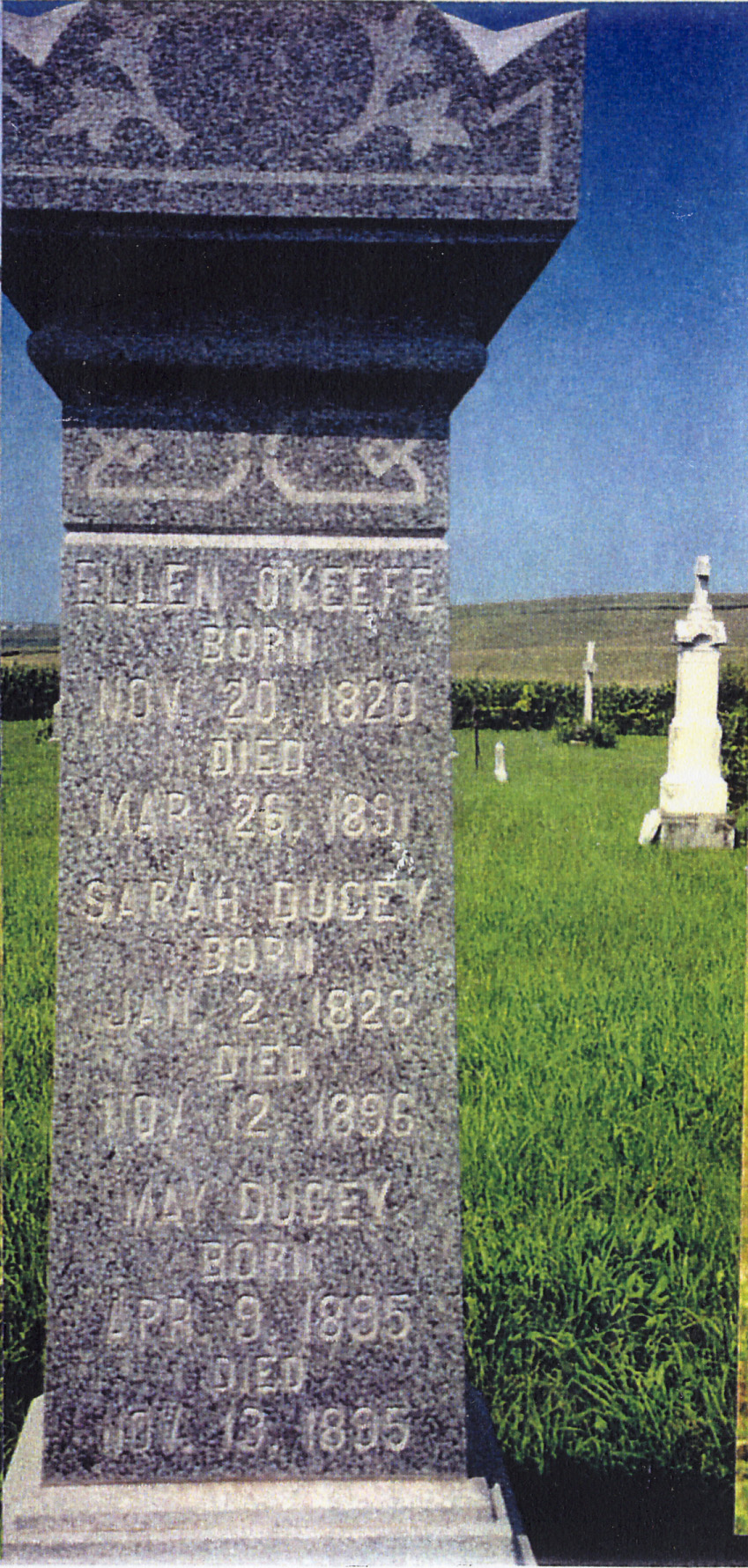 Catherine Ducey Moore, b. 1829, widow of Thomas Moore. Died 10 of June 1888 at Lindsay Nebraska.
Catherine Ducey Moore, b. 1829, widow of Thomas Moore. Died 10 of June 1888 at Lindsay Nebraska.
Ellen Ducey O’Keefe, b. 1820, widow of Daniel O’keefe. Died 28 March 1891, location and date of death uncertain.
Sarah Ducey, b. 1826, spinster, died 12 November 1896 at Lindsay NE.
As is often the case with legal records for women in the earlier years of the 19th century, other than births, marriages and census records, it has been difficult to find much recorded information about the lives of the daughters of John Ducey and Bridget Brohan.
Both helping and hindering our Ducey search is what I consider to be a “Family Memorial” stone rather than a gravestone, that was erected at Saint John’s Catholic Cemetery at Tarnov Nebraska, just south-east of Lindsay NE. It is helpful in that it provides the only specific birth and death dates we yet have for Sarah Ducey and Ellen Ducey O’Keefe. It was erected some time after the death of Sarah in late November 1896 and perhaps as late as 1910 or 1935. It is a hindrance in that it provides the tendency to assume that Ellen, whose name is at the top of the memorial, is actually buried there. I don’t believe that she is.
The Family Memorial stone has been photographed at Tarnov NE by Jack Ducey. It has also been posted on line at “FindAGraveIndex,” ( photo no. 31089011) taken by Shirley (Bruhn) Martys, 02 Nov. 2008.
Patrick’s 1904 obituary states that he was buried “beside his two sisters who died several years ago.” We can assume that they are Sarah and Catherine. We have census evidence for both, and in the case of Sarah, land records, which confirm that the “two sisters” buried at Tarnov, near Lindsay NE must be Sarah Ducey and Catherine Moore. Despite extensive searches in both Canada and the U.S., we cannot find any trace to indicate that Ellen ever lived in Nebraska. (SN 2.9._1)
Catherine Ducey Moore is not listed on the Family Memorial stone. This may be because Catherine was the first sister to die, in 1888, and was buried elsewhere in the same cemetery. Our source comes from the “Find A Grave Index.” (Photo no. 3108901, taken by Shirley Bruhn) Martys, on Sept. 15, 2009). Her post shows the individual gravestone of Catherine Moore and lists her year of birth as 1829 and her death in 1888, some 8 years before the passing of Sarah in late 1896.
Also listed on the Family Memorial Stone at Tarnov is a child: May Ducey Born 09 April 1895, Died 13 November 1895. She was most likely a grand-daughter of James and Johanna Ducey.
Because of the difference in death dates between Ellen O’Keefe and the other two on the Memorial Stone, (Sarah 1896 and baby May 1895) we cannot be precise about when the stone was put up but it was at the earliest, in late 1896, five years after its stated death date for Ellen.
The memorial stone could have been erected by any of the surviving brothers, Daniel, Patrick or James. My theory is that, with the death of the last sister, Sarah, it was placed in the cemetery at Tarnov NE by a later generation of Ducey descendants, perhaps well into the 20th century, maybe even some time after the deaths of Ann Duke Ducey in 1910 or Johanna Doherty Ducey in 1935. Patrick Ducey has his own grave stone in the same cemetery (photo taken by Jack Ducey.) He, like brother James, also has a published obituary. The question that remains to be answered is where did the death date for Ellen come from?
3.0 Ellen Ducey O’Keefe, b. 20 November 1820, d. 28 Mar. 1891. Ellen Ducey O’Keefe remains an enigma. For this project, with the exception of Michael Ducey, more time has been spent trying to confirm the few details about her life than the total amount or research time spent on her other five siblings. Still, the exact date and place of her death cannot yet be confirmed.
She was born six years after the oldest brother, Michael. Her birth date is based on Lindsay NE memorial stone that carries her married name, Ellen O’Keefe. That year of birth is confirmed in the 1871 Canada Census.
Records from St. Mary’s Church in Lindsay ON show that “Ellen Ducey, daughter of John Ducy and Bridget Brohan, deceased” married “Daniel Keef” (sic) son of Timothy Keef, deceased and Judith Markly(sp?) of Ops “on 19 February 1849, just two years after the Ducey family arrived in Lindsay. The marriage was witnessed by John Cuddy and Johanna Keef – not by any member of her family. However it should be noted that the Cuddy family were very close to the Ducey family.
A daughter, Mary, was baptized the same year at St. Mary’s in Lindsay on 26 November 1849. The sponsors were John and Mary Cuddy.
These two citations of Daniel O’Keef are the only certain records yet confirmed for this Daniel Keef. However, a Daniel Keefe was enumerated in the 1861 Canada Census under the “All Places (Agricultural” section. This was a designation used for rural inhabitants who were outside town or village boundaries. It simply gives his name as” Daniel Keefe”, no age, etc. and lists the area as” Peterborough”, not too distant from Lindsay, perhaps an hour away by horse and wagon in 1861. If this is the same Daniel O’Keefe, farming may have taken him to reside in that location. Another Daniel O’Keefe was found at Asphodel in Victoria Co., dying there at age 80, but he does not fit the profile of Ellen O’Keefe’s husband. (SN 3.0, _1)
We have not found husband Daniel O’Keefe in any further Victoria County records. (Do not confuse him with another” Daniel O’Keefe,” the one born in Lindsay in 1847.)
Ellen” OKeef” appears separately in the 1861 Ontario Census, as living in Ops Township with her birth date given as 1821; religion, Roman Catholic; born in Ireland. This matches her profile as we know it.
However, a second reference to Ellen has been found for Ellen and her daughter. Ancestry.com carries a printout of an 1861 Census sheet for Victoria Co. with handwritten enumeration on it. On line 18, we find “Ellen O’Keef,” age 40, born in Ireland, followed on line 19 by “Mary O’Keef,” age 12. Both are marked as female and single,” living in a log house.” One cannot read too much into the fact that she was marked down as” single,” along with her daughter. It could have been an assumption by the enumerator that she was either divorced or a widow by that time and thus “single”. (SN 3.0 _2)
Their neighbors were identified as Patrick Jordan, Irish, on line 17 and Robert and Rebecca Curley, also Irish, on lines 19 and 20.
We also have a record from www.familysearch.org that shows the death of a Mary “Okeefe” on 19 June 1884, age 32 at Lindsay ON. Ellen’s daughter, Mary “Okeef ” was baptized at St. Mary’s, Church, Lindsay, on 26 Nov. 1849, and would have been aged 34 – 35 on that death date, but the two dates are close enough to suspect that this could be the “Mary O’Keef,” daughter of Ellen “O’Keef” enumerated together in 1861.
Research shows that there were at least three and probably more Keef, O’Keefe or Kief families living in Lindsay and Ops Township during the 1840’s into the 1860’s. Moreover, a Kevin John O’Keefe, still living in Lindsay in 2013, was searching online for more information on his Irish ancestor who arrived there about 1844. He wrote that his John O’Keefe opened a shoemaker’s shop in Lindsay and that generations of this O’Keefe family have lived there since.
To muddy the water a bit more, as recently as April 2015, an unrelated family website on Ancestry.ca has linked the marriage of Ellen Ducey and Daniel O’Keefe to members of its family. To date, we have found no further information about the family life of Daniel and Ellen Ducey O’Keefe.
Elsewhere in the 1871 Ontario Census, we find another three Ellen O’Keefes, born in Ireland in the 1820s but none of these fit the profile of Ellen Ducey O’Keefe. About 20 more are found in the U.S.A.
Although Ellen O’Keefe’s name, date of birth and death (26 March 1891) appears above that of sister Sarah on the Family Memorial stone in Nebraska, we cannot prove that she was ever in Nebraska. Unlike Sarah and Catherine, she is not found in either of the U.S. and Nebraska census lists of 1880 and 1885.
All of the confusion about Ellen Ducey O’Keefe could be avoided if we could find solid evidence of her death, either in Nebraska or in Canada. Extensive searches of U.S. death records for the period show almost 20 Ellen O’Keefe’s born in Ireland in the 1820’s, but none of them are a match for Ellen Ducey O’Keefe.
It is conceivable that Ellen Ducey O’Keefe could have come to Nebraska to join her sisters after the 1880 U.S. Census, then been missed in the special Nebraska Census of 1885 (as was Patrick with the other two sisters) until her death in 1891. However, as yet, there is no sign of her in Nebraska or anywhere else!
Making the situation more difficult is that nearly all 1890 U.S. Census records, including those of Nebraska, were destroyed in a fire in 1921. Had they survived we would be able to deduce a good deal more about these Nebraska Duceys.
To recap, the Family Memorial stone is the only record we yet have for Ellen Ducey O’Keefe’ s birth and death. The 1861 census record confirms her year of birth in 1820. We do not yet know where Ellen died or when she died. We have been unable to find evidence of her death in both Canadian and U.S. records.
However, one slender connection remains. In the 1881 Canada Census for Victoria County, we find an Ellen O’Keefe, age 70, living with the family of William King in Ops Township. We suspect this Ellen O’Keefe was a housekeeper for the Kings who were first listed there in the 1871 Census.
By the 1881 Census, William and Mary King were both age 47 with three children, who probably required a housekeeper by the late 1860s and early in the 1870s. The area in which these people lived, in the south-west corner of Ops Township, was then heavily populated with Irish immigrant families. The Kings lived in Family Home No. 277. Daniel Ducey and Ann Duke lived in Family Home No.279.
Michael Ducey and Catherine Teevin lived in Family Home No. 291; their daughter Mary and her husband Patrick James O’Connell lived in Home No. 283, while Michael’s close friend George Breen lived in Home. No. 287. John and Mary Teevin were in Home No. 290. So it is very possible that the single Ellen Ducey O’Keefe would be living among this group, and according to the 1881 Census, living with the King family in Home No. 279. Thomas Moore, who married Catherine Ducey in 1863, had some of his family living close by this area as well.
We note that the 1881 Canada Census was taken on April 4, a week after the March 28 date of Ellen’s death, as listed on the family memorial in Nebraska. The age recorded for Ellen, 70, in 1881, implies a birth date of 1811, some 10 years earlier than the date of 1821, which is backed up in the 1861 Census.
However such a date variation, or conflict with another, is often found in the 1800’s. In this case, someone answering the enumerator in the King household may have guessed her age as “70-ish.” We know from the 1861 Census that Ellen was no longer then living with husband Daniel O’Keefe. We do not know if Ellen separated from husband Daniel O’Keefe or if he may have died by then. We suspect that Ellen worked as a house maid in Ops Township.
Despite extensive searching of church records and local newspapers in the Lindsay area around either side of 1881, we cannot find any further trace of this Ellen Ducey O’Keefe. Nor is there any further trace found of her daughter Mary after the possible date of death for the Mary O’Keefe mentioned above.
By the 1891 Census, surviving members of the King family had apparently moved to the Toronto area.
3.1 Sarah Ducey, b. 02 January 1826, d. 12 Nov. 1896. Sarah never married. There is little known about her personal life, which was largely spent supporting her father and her farming brothers from the time her mother passed away upon arrival in Canada. The first reference we find for her is in Ontario when she is listed as a witness at the wedding of Daniel Ducey and Anna Duke in Lindsay on 05 February 1856.
In Nebraska ,she is found living with brother Patrick in the 1880 U.S. Census. She is listed as “keeping house” for he and his hired hands. We cannot determine if Sarah emigrated with brother James in 1872 or if she came down later, once Patrick had had obtained his first homestead land in 1873 and built a proper house. With brother Michael marrying the testy Catherine Teevins-Lynch in 1867, and moving in with two of her John Duke daughters, Sarah may have jumped at the chance of an early departure from Michael’s property. (SN 3.1, _1)
However we do find a pleasant surprise about Sarah’s life in Nebraska. Sarah Ducey first shows up in the U.S. when she is successfully listed as a “patent holder,” by the Land Office at Grand Island, Nebraska on 29 March 1880.
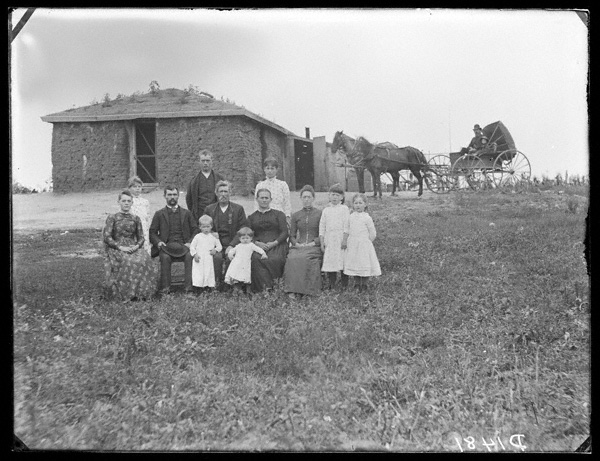
A Nebraska family dresses up for a formal photo in front of their sod house.
Nebraska State Historical Society, Digital ID. 10832
In this case, Sarah was named as the first owner of 160 acres of homestead land, adjacent to that of Patrick. Patents for both Patrick and James were recorded at the same time, but at the U.S. Land office at Grand Island, Nebraska. These three patents had to have been applied for by mid-March, 1879, so she would have been a Nebraska resident at least by then and probably much earlier. No doubt either Patrick or James had done the paper work for her and she was given 80 acres on the south-eastern quarter of Section 21 and 80 acres on the south-west quarter of Section 22, just south of the village of Lindsay.
We have no further information about Sarah, except that which appears on the Family Memorial stone at Saint John’s Catholic Cemetery at Tarnov, NE. As the last of the three Ducey sisters to die, one might conclude that she (and perhaps Baby May) was laid to rest at the foot of the Memorial Stone.
3.2 Catherine Ducey Moore, b. 1829, d. 10 June 1888. The youngest daughter, she is first found along with father John and brother Patrick, as living at Ops with brother Michael in the 1861 Census. It confirms her year of birth. At the same time, a Thomas Moore was enumerated as living just north of Ops Township. in Fenelon Township.
On 18 July 1863, Catherine married Thomas Moore, b. 1827 in Co. Clare, Ireland, according to their Lindsay church record. His parents were listed as “Frederick Moore and Elizabeth Smith, formerly of Dublin”. The witnesses were brother Patrick Ducey and Mary Keefe. This latter name leads me to believe that Daniel O’Keefe was indeed Daniel Keefe when married to Ellen in 1849, although his name was misspelled at the time by the priest as “Keef”.
Thomas Moore appears in St. Mary’s parish records as a baptismal sponsor for several nieces and nephews of Daniel and James over the next four years. He is last found in the Canada Census of 1871, listed as living in House No. 309, in Ops Township, not far from Michael and Daniel Ducey. Catherine is not shown on his enumeration.
To confuse matters, the 1871 Census also shows another Thomas Moore and his family, a wife Catherine Moore, and five children, living in Pickering Ontario. This Thomas Moore was born in 1831 and had a daughter, Mary Ann, born in 1857. They should not be confused with the Lindsay/Ops Township Thomas Moore.
We next find Catherine Ducey Moore in the U.S. Census of 1880, at age 50, recorded as born in Ireland and living with brother Patrick at his property in Platte Co. Nebraska, along with sister Sarah, age 47.
Both women are described as “keeping house.” (Patrick usually had a hired man or two on his property, some with young children so there would be a lot of housework!). On the Ancestry.com website, both Patrick and Sarah are marked as “single” but Catherine Moore is identified as a “widow” and that hand-written designation shows on the original enumerator’s census sheet. (SN 3.2._1)
We have yet to find any record of the death of Thomas Moore between his 1871 Census listing in Lindsay, Ops Township, and Catherine’s enumeration as a widow in Nebraska in 1880.
However, to the contrary, a family listing on Familysearch.org states both Catherine and a Thomas Moore lived and died in Etobicoke, Ontario, she at age 66, 04 April, 1895 and he at Toronto on 23 May 1897. It claims this was the couple married in Lindsay ON 18 July 1863. That is not correct.
This is an example that shows one cannot take genealogical websites at face value where family records are involved, because descendants can post family records with unsubstantiated and incorrect information. I have run into several other such instances during this project.
Our Catherine Ducey Moore, was enumerated as a widow living in Nebraska with Patrick and Sarah in the U.S. Census of 1880. The “Find A Grave Index” photo (no. 31089011), taken by Shirley (Bruhn) Martys on 15 September 2009 of her stand-alone grave stone shows that she died 10 June 1888 and was buried at Saint John’s Catholic Cemetery at Tarnov, NE. This is the same cemetery where sister Sarah Ducey was buried on 22 December 1896.
Catherine’s grave stone listing gives her birth date as 08 May 1824, but earlier records, including both Canada and the U. S. Census reports, confirm her birth year as 1829 or 1830. Again, in an era when birth dates were seldom recorded for adults, other than in a family bible, the descendants who put up grave or memorial stones, did not always get the date of birth correct. Lacking official death records, I consider official census records (the earlier the better) to be more reliable than grave stone listings. Of course, in the days of scant records, as the years passed, older people themselves may have confused their own birth date when speaking to descendants. (Later in life, both Michael and James Ducey gave birthdates contradictory to dates given in earlier census enumerations .)
To confuse the Catherine Moore question a bit more, the website Ancestry.ca also carries an 1891 Canada Census report that indicates another Thomas and Catherine Moore were enumerated at Whitby, Ontario. It shows both were born in Ireland. Their ages are both given as 61, therefore born in 1830. Her date fits but their marriage record at Lindsay states he was born in 1827. However this posting does not claim that this is the couple who were married in Lindsay ON 19 July 1863, witnessed by Patrick Ducey and Mary Keefe. But it does illustrate the care that must be taken when using these records.
3.3 Daniel Ducey b. 1821 (no exact birth-date) d. 29 Oct. 1894. Daniel would assume the role of eldest son at home in Ireland after Michael left about 1840. He would be age 25 when the family left Ireland for Canada. His will shows that Daniel died at Lindsay NE on 29 October 1894. There is no Nebraska obituary yet found, other than a two-line mention of his passing in an unidentified Nebraska newspaper.
Daniel married Ann Duke at Lindsay Ontario on 05 February 1856. She was the fifth child of Ferguson Duke(deceased) and Bridget Teevan, both born in Ireland. Witnesses at the marriage were Sarah Ducey and John Duke. Records of that family show that Ann Duke was born 31 March 1841 in Toronto (then York) Ontario. (SN 3.3.1) If accurate, she would be two months short of age 16 when married. She would give birth to 13 children and live to the age of 69.
My assumption is that father John Ducey and the six children all lived on Michael Ducey’s Lindsay ON property until they either married and left, or in the case of the sons, were able to obtain their own properties. As mentioned above, Michael, Daniel and James are listed as each farming between 70-100 acres in the 1861 Ontario Agricultural Census.
Like Michael, Daniel later accumulated additional properties along the Scugog River area. He would eventually hold the following properties in Ops Township:
Concession 2, part of Lot 5 = 24 acres on the East bank;
Concession 2, west half of Lot 9 = 20 acres;
Concession 2, east half of Lot 9 = 100 acres,(located just north of Michael on the west side of the river). (SN 3.3 _1).
In the Canada Census of 1871, Michael Ducey’s house number in Ops Township was 291, while Daniel Ducey’s house number was 279. James, who we do not believe was a land owner in Ontario, does not show up in the June 1871 Census enumeration, while Patrick was probably gone to Nebraska earlier that year.
It would take Daniel 15 years after James’ departure, at the age of 65, to uproot his large family and join the others in Nebraska. Perhaps his age had something to do with it, or perhaps Patrick needed more help with his large Nebraska farm properties. A more likely reason is that as his family grew, Daniel was struggling financially and was often drawing down mortgage loans on various pieces of his three properties to bolster his monetary needs. (SN 3.3._2)
By 1881 he had 10 children to support and only one son, Patrick, was over the age of 12. While down in Nebraska, brother Patrick, with no children, was dealing with 320 contiguous acres plus another 160 acres held by sister Sarah.
Finally, at the urging of his brothers, Daniel decided to make the move. However it was April 1887 by the time he was able to sell or lease the property his home was on, described as follows in the Lindsay Post of 15 April 1887:
“A large number of friends assembled at union station on Tuesday of last week to witness the departure of Mr. Daniel Ducie, an old and esteemed pioneer of Ops. Mr. Ducie is now moving to Nebraska. It is hoped he may prosper as he left a very comfortable home in Ops. Mr. Ducie had a very large sale, one of the best that has been held in Ops for many years…. Mr. Francis Finnegan is moving on to the Ducie Farm. ”
The U.S. Census of 1900 confirms the family’s official immigration date as 1887. By then Daniel had missed the homesteading opportunities in Platte County. He left Ontario without registering the transfer of any of his three farming properties, apparently renting them out.
At this time, we have no information about where the Daniel Ducey family settled in Platte County, but we assume it may have been somewhere on brother Patrick’s lands. However, in the U.S. Census of 1900, Ann Ducey, “widow, age 61,” is noted as “owns a mortgaged farm. “Daniel would die seven years after settling in Nebraska. This property was transferred by Patrick to Ann sometime after Daniel’s death. (SN 3.3._3)

Patrick Ducey’s lands shown in the darkened area, left to Ann Ducey upon his death. Click on image for enlargement.
Oral family history tells us that in late October, 1894, Daniel suffered a gunshot would and died about a week later. I have a written notation in my research pages that refers to an undated item from page 6 of the Western News Democrat of Lindsay NE, undated, that states: “Last November, a son of Harmon’s shot and killed Daniel Ducey.”
I have been unable to find the origin of this notation or any other reference, such as an extensive obituary of Daniel Ducey, that might have been carried in any other Lindsay or Columbus newspaper of that era, had he been shot. Nor can any such reference to the death of Daniel be found on the usually very comprehensive web site for Nebraska’s Platte County Vitals.
So far, only one published trace has yet been found with respect to Daniel’s death, and that is in the form of a photo copy in a clipping that carries two lines from an unidentified Nebraska newspaper: “Lindsay, Neb., Oct. 31, 1895. Daniel Ducy Sr. died last Tuesday at his home south of here and was buried in St. John’s cemetery, Wednesday morning.”:
Reference to a shooting is found in the form of a 1994 memo about a conversation of two Daniel Ducey descendants. It was written by Shirley McCue, who interviewed Helen Butkus, the latter a grand-daughter of Daniel and Ann. Here is an excerpt from that conversation related by Helen Butkus: “Anna, the mother, was a very good business woman. She loved to dance. Her husband, Daniel, died of a gunshot wound. Loretta Mabel (youngest daughter of Daniel, then aged 11) remembers sitting on her Mother’s (Ann) knee as she dressed Papa’s wound. Could this be the wound by which he ultimately died? Shirley searched all records and could not find out how the gunshot wound occurred.” (SN 3.3, _4).
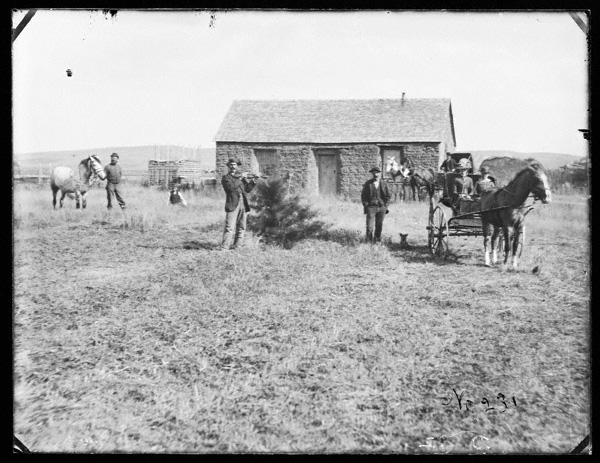
A Nebraska front yard in the 1890’s.
Credit: Nebraska State Historical Society – Digital ID. 10419
My research backs up that carried out by Shirley McCue some 20 years ago. Even with the expanded access to information in the form of today’s internet searches, I could find no trace of a shooting of our Daniel Ducey. Sudden or accidental deaths were usually carried in the local newspapers but it appears that our Daniel Ducey died a normal death. However. in the passage of time his death by shooting surfaced as family lore.
There was such a shooting in the family. But the victim was Daniel Ambrose Ducey, age 25, the son of James Ducey, accidentally shot near Lindsay by a careless teenager on 28 November 1899, five years after the 29 October death of Daniel Ducey Sr., (who also had a son, Daniel).
The four sons of John Ducey and Bridget Brohan all lived about the same lifespan, and appear to have died peacefully after decades of hard manual labor on their lands. Michael died aged 75; Daniel died aged 73; Patrick aged 70, and James, aged 77.
Daniel’s will was either drawn up or updated three days before he died on 29 October 1894. Fortunately we have a copy of it, due to the fact that he had never either sold or recorded the sale and transfer of his Canadian properties. After his death, to dispose of these lands, his wife Ann had to make a petition to Lindsay ON authorities, which included a copy of the final will and other documents which give us a unique look at the estate of Daniel Ducey.
Daniel Ducey’s last will was dated 26 October 1894, three days before he died, and witnessed in Platte County by his brother James Ducey and neighbor William Connelly. (SN 3.3._5)
His assets were left to wife Ann, who was also designated as executrix. The Ontario probate filing only mentions his house at Lindsay in passing but listed no other U.S. real estate assets. His Canadian real estate assets were estimated to be worth $1600 and his personal assets at $300. (SN 3.3._5)
The probate included this list of his survivors:
Wife Ann, residing at Lindsay
Ellen Hemenway, age 36, residing at Chicago, Illinois
Anna Ducey, age 34, residing at Platte Co., Nebraska
Patrick Ducey, age 31, residing at Erich, Oklahoma
Bridget Ann Segin, age 28, residing at Springfield, Illinois
Daniel Ducey, age 26, residing at Platte Co., NE
Catherine Wahl, age24, residing at Platte Co, NE
Thomas James Ducey, age 22, residing at Wayne, Nebraska
Agnes Ducey, age 19, residing at Platte Co. NE
Isabella Ducey, age 17, ” ”
Joseph F. Ducey, age 15, ” ”
Amelia Ducey, age 13 ” ”
Mabel Ducey, age 11 ” ”
Ann Ducey petitioned the Probate papers to the Surrogate Court in the County of Victoria, Ontario, on 14 May 1895. The three properties either sold or transferred were:
Conc. 2, Lot 9, to Thomas Rey for $500.
Conc. 2, Lot 5, to George Mills, for $800
Conc. 2, Lot 9, to Margaret Fanning for $1200
Mortgage liens against the properties were expected to total about $666, for a final net sum estimated at $1900. (SN 3.3, _6)
My grandfather, Thomas James Ducey, one of Daniel’s youngest sons, born at Ops Township in 1871, wrote the following: ” Speaking of my father, Daniel, I once met a neighbor of ours, who lived across the road from the Ducey family, 8 miles from Lindsay. I was living in Buffalo, N.Y. at the time. The neighbor told me that my father was a good neighbor and ‘a dam good judge of a horse’. He also wrote that his father was too busy trying to feed his family to tell him anything about his days past in Ireland.
Daniel Ducey ‘s wife, Ann Duke, enjoyed a long life before she died 03 June 1910 and was buried next to him. Her obituary , reprinted in the Lindsay ON Post on 01 July 1910 referred to her as “Anna” Duke and that is her name on their gravestone, erected some time after her death in 1910. However records show that she was Ann Duke when married, listed that way in all census records and is mentioned in husband Daniel’s deathbed will as “my dear wife Ann.” In the probate and other legal papers the spelling is Ann. The confusion may have come about from the fact that her sister-in -law, Johanna Ducey, wife of James who was usually referred to as “Anna.” Or, it could also be that the grandchildren of Ann Duke had been in the habit of calling her “Anna.” (Note above that in the 1994 interview with Helen Butkus, she referred to Ann Duke Ducey as “Anna.”)
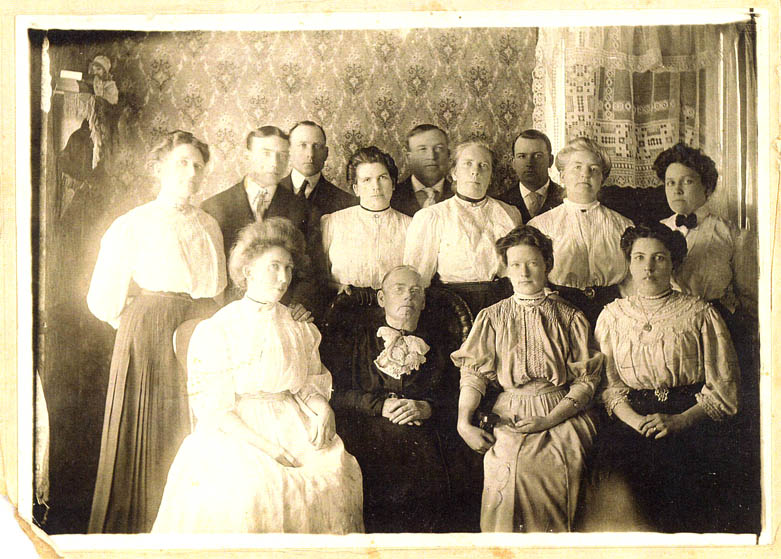
Ann Ducey (center-left), widow of Daniel, in a photograph with 12 of her 13 children, taken at Lindsay, Nebraska, in 1908, two years before her death.
3.4 James Ducey, b. 15 August, 1830. He is the only one of the four Ducey brothers for whom we have no legal Ontario land ownership records. I believe that he lived and farmed on Michael’s property while in Ops Township. He, wife Johanna and daughter Bridget are found in the 1861 Canada Census at Ops Township. The names of his closest neighbors at the time, all Irish, were the Miller, Riley and the Cuddahee families. He and Daniel also appear in the 1861 Agricultural Census, as each farming 100 acres in Ops Township, while Michael is listed six lines below them, as farming a 70-acre section of land.
On 26 May 1856, a few months after Daniel’s wedding, James was married to “Johanna Doherty, the daughter of James Doherty, deceased, and Bridget Healy, also of Ops.” Johanna is reported to have been born in County Kerry, Ireland on 30 October 1836. (SN 3.4._1) The Doherty name later came to be spelled as “Dougherty” in U.S. records. With no land ownership titles of his own in Ops Township, James would be a natural candidate to emigrate to Nebraska and gain a large homestead property for he and his family. Once he got a favorable report back from Patrick he and the family left Ontario in 1872.
His family joined the second group of Lindsay neighbors who decided to follow the John Walker, Samuel Connelly and Patrick Ducey group, who had left for Nebraska a year earlier. Unlike Ontario Crown land offered at 100 acres, the U.S. homestead grants were 160 acres, one and a-half times larger.
In 1880, James, along with siblings Patrick and Sarah each received a 160-acre homestead grant just south of Lindsay. Added to Patrick’s first 160-acre acquisition in 1873, the Duceys together then owned 640 acres of Nebraska farmland. But they were not finished. James had daughter Bridget apply for a land grant when she turned 21 and she too received 160 acres near his property on 10 February, 1885. Unfortunately Bridget would pass away four years later, aged 29.
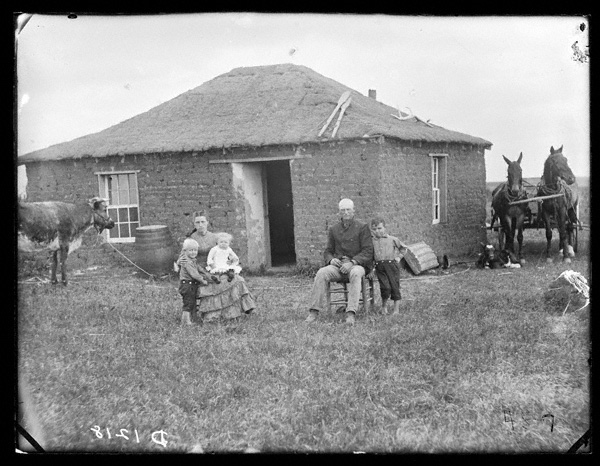
A Nebraska sod hut – in the 1890’s.
Credit: Nebraska State Historical Society – Digital ID. 10623
James was very civic minded. Along with his son, John Joseph, he was one of the petitioners who successfully pushed for the incorporation of the village of Lindsay in 1888, then with a population of 200. James Ducey was one of six men appointed to the first board of trustees for Lindsay NE. (SN 3.4. _2)
Johanna and James had five children born in Lindsay ON. They were Agnes, Bridget, John J., Michael and Eliza. Mary, Mabel and Daniel Ambrose were born in Nebraska. In the U.S. Census of 1900, Johanna was recorded as having ” 11 children, 8 living.” As sometimes asked by enumerators, a notation made then also stated that she “cannot read or write.” On that same census, James was noted as “head of household, a naturalized citizen, owns a mortgaged house.”
The second youngest of the family, James outlived all his siblings. By 1902 he had retired from farming. He and Johanna moved into a home in Lindsay village and would celebrate their golden wedding anniversary there in March, 1906. Earlier, the hard life of a bachelor farmer had also worn down younger brother Patrick to the point where he sold off his farmland and moved into the Lindsay house with James and Johanna. Patrick left his farm properties to Ann Duke, widow of Daniel. In the 1900 US census she is showing as residing there along with some of her children.
The 1900 US Census also showed a 16 year-old grand-daughter, Sadie Moore living with them. She was the daughter of Agnes Ducey and James Moore, who were married in Platte Co. in 1880. Also listed as a resident was a grandson, James West, age 8. (SN 3.4. _3).
James Ducey died at home aged 77, on 03 October 1907 However Johanna Dougherty would live to age 95, passing away on 14 September, 1931, by then the oldest resident of Lindsay. She was survived by five of her ten children. Among the Ducey family she was also the last of her generation.
From the birth of John Ducey about 1786, to the death of his son James in 1907, the life span of this family was about 120 years. For the poor, almost illiterate farming class, it was twelve decades of struggle, poverty, hard manual work, illness and famine, marked by a desperate but courageous gamble for a better life on another continent. It was also the bridging period between an agrarian economy and the welcome domestic benefits of the industrial revolution. However this family would not see the full fruits of the latter. They went from living in mud huts to log cabins and eventually a warmer, drier class of comfortable housing. They just missed seeing the work of horses and oxen give way to the internal combustion engine. During their move from one Lindsay to another Lindsay, they did experience railway transportation. In their final years, they just missed the comforts of electric lights and power, along with the introduction of abundant, indoor municipal water services. Yet they kept their faith and each evening, they gave thanks for a hard day of work that allowed them to put food on their tables and save a dollar now and then.
Today, in the 21st century, their many descendants have been blessed by the fruits of their labor.
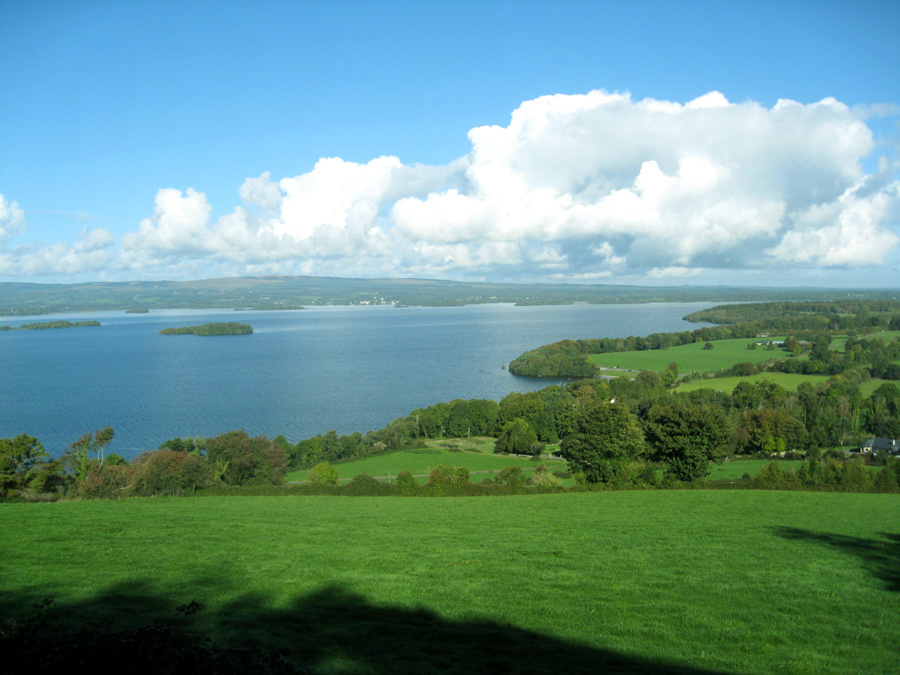
Looking north west above the village of Portroe, Tipperary, across Lough Derg, towards the east bank of County Clare
Conclusion:
We have not achieved our two primary objectives for this research effort into the history of the family of John Ducey and Bridget Brohan — exactly where in Tipperary County did they come from and exactly when did they arrive in Ops Township, Victoria County, Ontario?
Oral family history confirms that they came from near Nenagh , Tipperary. Research to date leads us to conclude that the John “Doosey” who left Lot 31 in the townland of Townlough Upper, Parish of Portroe, in late 1846 or early 1847, is our forefather. We know that his wife, Bridget Brohan, died and was buried at Lindsay Ontario August 6, 1847.
We strongly suspect that Townlough Upper was not this family’s ancestral home, but a temporary location selected for economic necessity. The current dearth of baptismal, land and ships’ records for many of this class of illiterate, immigrant Irish farming families in the early 1800s prevents a concrete conclusion to our research so far. However the process has told us a great deal about this family, particularly about their lives in Lindsay Ontario and Lindsay Nebraska. Although we have made an another attempt to find them among the recent release of Irish parish records, it has not been successful — yet. More clarity may come from these records over the next year or two.
Meanwhile, any evidence that others might contribute to our search would be most welcome.
Updated 17th of March 2016.
Acknowledgements. As stated at the beginning, this project evolved from research that started with Gerry Ducey about 1995, the time that the internet offered a new avenue to those interested in genealogy. In 1993, his brother Jack Ducey, who lives near Medford, Oregon, had visited and photographed Ducey family gravesites in both Lindsay, Ontario and Lindsay, Nebraska. Gerry began to link together the descendants of the Daniel Ducey family. By 1997-98 he had a network that expanded to descendants of other branches of the Ducey family, i.e. the siblings of Daniel, who had arrived from Tipperary Co. to Lindsay, Ontario in 1846-47. Also drawn into this effort by his charm and enthusiasm were those closest to him. Wife Donna Lee, sister Cathleen, brother Jack and his wife, Pat, and their daughter Bev. They found themselves visiting relatives they had not seen for years, some never before. On separate occasions they tramped through cemeteries in Lindsay, Ontario, Lindsay, Nebraska and Tipperary, Ireland, often pausing to search through old newspapers and faded church records.

Cathleen, Gerry, Brant and Jack Ducey, March 2012
In Lindsay ON, brother Jack visited with the late Rita Fisher, a direct descendant of Michael Ducey. It was there that Jack discovered the 1847 grave stone of Bridget (Brohan) Ducy. Soon the circle included other newly discovered relatives and others who had been doing their own family research. To my knowledge, these included Nancy Stout, Shirley McCue, Diane Luxton, Gynon Nash and Kristie Hemenway. There may have been others that I am not aware of, but we hope to hear from them once this site is posted.
About 2007 I began my own project, to document the history of the larger Ducey family which began in Ducey, France about 1100. Finished with that in early 2012, I joined in with Gerry and Jack and told them that I would concentrate on the Irish origins and the story of the John Ducey-Bridget Brohan family. With Gerry’s unfortunate passing at Christmas 2012, the effort to link a wider circle of descendants ended, for now. Hopefully this website will get it moving again, with someone else taking on that task. However either listed below or on a separate website will be the work Gerry did with respect to descendants of Daniel Ducey and Ann Duke.
Meanwhile, in addition to those participants mentioned above, I would like to mention some others who have helped bring this particular site together. One who helped Gerry and myself to focus on John Doosey of Townlough Upper, Parish of Portroe, is Marty Krauter of Beaverton, OR. His wife Kathleen descends from another John Doosey found near Portroe. Marty discovered the slender thread of evidence supporting the original family claim that they came from Tipperary Co, Ireland.
Providing significant information and important records about the Lindsay Ontario part of this story was Michael Stephenson with his comprehensive Ontario-focused web service, www.ontariogenealogy.com. Helping with the Irish research and direction was Dwight Radford, who works out of Salt Lake City, Utah, well known in(but not limited to) Irish genealogical circles, whose website can be found at www.the journeyhomegenealogy.com.
My driver and tour organizer on our recent photographic trip to Lindsay ON and then on to Ireland, was friend David Todd of Ottawa, who never once flinched in the face of left-hand driving on the new-to-us Irish auto-routes. Ireland traffic has changed a great deal since our first trip together there in 1986. In Ireland we were helped by the staff of the National Library of Ireland in Dublin and by the staff of the North Tipperary Genealogical center at Nenagh. At Lindsay ON were assisted by Peter Robson and the staff of St. Mary’s Roman Catholic Cemetery.
As with my first web site, www.duceysfromducey.com, this one has been put together by my daughter Krista, whose work can be seen at www.lynkswebservices.com.
Finally I would like to thank my patient wife, Dagmar, who has lived without seeing me for many days and evenings over the past four years. Her Swiss family records dating back to the late 1400s are extensively and neatly preserved in one little town in Canton of Vaud. If only the Irish had been at liberty to do much the same….!!!
I can be reached at: brantducey@gmail.com
Source Notes, by numbered Section, i.e. 1. 1
Note: Unless otherwise indicated, all dated records of Ducey related marriages, births and deaths at Lindsay ON are found in the on-line records of St. Mary’s Roman Catholic Parish at Lindsay, originally known as The Purification of the Blessed Virgin Mary Parish, Lindsay ON. They can be found at www.familysearch.org. Also found there are the early the archives of St. Luke’s Roman Catholic Parish at Downeyville, Ontario, but no Duceys are found there.
1.1 Duceys In Ireland.
SN 1.1_1 Tipperary’s Families, Hearth Money Records for 1665-6-7, Thomas Laffan, James Duffy Co, Dublin 1911. pp. 15, 148.
1.2 Not The Only John Doosey. ..
SN 1.2_1. Co. Tipperary Tithe Applotments, 1824, Griffiths Valuations for Ireland. www.ifhf.rootsireland.ie
SN 1,Letter, 1.2_2. Thomas James Ducey to Brant Ducey , 23 November 1959.
1.3 What do we know about the John Ducey/Bridget Brohan Family? SN St. Mary’s Parish, Lindsay ON. SN 1.3._1. Death of John Ducey, 07 April 1866.
SN 1.3._2. Lit 31, Townlough Upper, FHC Film #2358276
SN 1.3._3. Letter, Thomas J. Ducey to Brant Ducey, 23 November 1959.
2.1 Bridget Brohan
SN 2.1 _1 Marriage Record, Cahir Parish 02 Feb. 1809. www.rootsireland.ie/tipperarynorth/ John Ducy m. Bridget Ducy (sic.).
SN 2.1 _2, Ships’ passengers to Australia. A list of young passengers with passage prepaid to Australia. Tipperary Immigrant Index 1828 – 1856. www.Rootsweb.freepages/genealogy.com
SN 2.1 _3, A list of deaths in North Tipperary, 1847.
SN 2.1. _4, Government of Canada, Historic Sites, Grosse Ile, Qubec. Also, TRIPOD…
2.2 John Doosey of Townlough Upper.
SN 2.2. 1. _1, A Topographical Dictionary of Ireland, Samuel Lewis, S. Lewis & Co. 1837.
2.2, _2, 1861 Census of ireland…..
2/2. _3, Field Book, Family History Center, Salt Lake, Utah, Film (FHC.
2.2. 4, House Book, Family History Center, Salt Lake, Utah, Film FMC
2.2. _5, Archives.rootsweb/ancestry.com, Nenagh Guardian, 18 May 1843
2.3 Why would tenant farmer john Doosey leave Tipperary…
2.3. _1, There is a massive collection of books and reports on the Famine Years. One most relevant to this project is Donald MacKay’s Flight From Famine, The Coming of the Irish to Canada, McClelland & Stewart, Toronto, 1990. See also : Annals of the Famine in Ireland, Asanath Nicholson.
SN 2.3. _2, www.cppi.dippam.ac.uk/documents. Abstract of Police Reports and principal outrages in counties of Tipperary. et. al. 1845.
SN 2.3. _3, The Evidence of Francis Spaight, July 1847, by J. O”Connor, Famine Edition. also, www.rootsweb.ancestry.com/fianna/migration.
2.4 What do we know of the Lindsay area…
SN 2. 4. _1, www.ontariogenealogy.com/ History of the County of Victoria, Watson Kirkconell.
SN 2.4. _2 Extract from the Immigration Report of 1846, Marj Kohli, University of Waterloo.
SN 2.4. _3, Loc. cit.
SN 2.4. _4, Ibid.
2.5 Michael Ducy
2.6 Land records relating to Michael Ducy.
SN 2.6. _1, Land record, Township of Ops papers, Survey of Conc. 2, Lot 8, M. Deane, P.L. Surveyor. 03 August 1852, Lindsay.
SN 2.6. _2, Land record, Township of Ops, Conc. 1, Lot 2, 27 Nov. 1857, Lindsay.
SN 2.6. _3, Loc. Cit.
2.7 The Lindsay Duceys of Ops Township ON and Platte Co. NE.
SN 2.7 _1, 1861 Canada Agricultural Census, Ops Township.
SN 2.7 _2, Land record, Township of Ops, Conc. 2, Lot 8,, 18 June 1863, Lindsay.
SN 2.7 _3, Parish of St. Mary’s, 7 April 1866.
SN 2.7. _4, Ibid., 24 November 1887.
SN 2.7. _5 Land records, Township of Ops, Conc. 2, Lot 8.
SN 2.7. _6, St. Mary’s Parish, 07 April 1889.
2.8 Patrick Ducey
SN 2.8. _1, 20 February 1865. Patrick buys “broken lot” of 20 acres Conc. 2, Lot 8, on east side of Scugog River from Bernard Coyne & Wife for $160.00 On 29 March 1867, Patrick buys 20 acres of the same lot form Coyne, but on the West side of the river for $231. He later sold this piece to brother Daniel for $500 4 July 1878, who was probably farming it since Patrick left for Nebraska in 1871. Land records, Township of Ops, Conc. 2, Lot 8.
SN 2.8. _2 “Past and Present of Platte County, Nebraska,,” Volume 1, pp. 345-6, also: www.olden-times.com/oldtimenebraska/NEGenWebProject.com
SN 2.8 _3, Ibid. Vol. 1, Chapter 23, pp. 316, 317.
SN 2.8. _4,Ibid. p. 176.
SN 2.8. _5, 1880 U.S. Federal Census, Pleasant Valley, Platte, NE, District 97.
SN 2.8. _6, Excerpt from a published but-yet unidentified document on the history of the Town of Lindsay, p. 5. “Pat Ducey did a lot of work on the railroad….etc.”
SN 2.8. _7 Obituary of Patrick Ducey, The Humphrey Democrat, found at www.rootsweb.ancestry,com/neplatte/vitals/
SN 2.8. _8, The amount in today’s U.S. $’s was calculated at www.measuringworth.com
2.9. Sorting out the Three Sisters
SN 2.9 _1 Loc. cit. Obituary of Patrick Ducey, The Humphrey Democrat.
3.0 Ellen Ducey O’Keefe
SN 3.0, _1. 1861 Census, Ops Township, Victoria Co., All Agricultural Census.
SN 3.0, _2, www.ancestry.com, 1861 Canada Census, Ops Township.
3.1. Sarah Ducey
SN 3.1, _1. Normally the date of her border crossing would be contained in the 1880 U.S. Census listing but it does not appear there.
- 2. Catherine Ducey Moore
SN 3.2, _1. U.S. Census of 1880, Line D-200. www.ancestry.com.
3.3 Daniel Ducey
SN 3.3,_1, Information about the Ferguson Duke- Bridget Teevins family comes from research work done by descendants of that family. I have not found any formal records relating to them, i.e. immigration or census records, or deaths, largely due to their early arrival in Canada. Information gathered by Kathleen Logan and others says that both the Teevan/Teevins and the Ferguson Duke families came from County Cavan, Ireland. Ann Duke is said to have been born March 31, 1841, in Toronto (York at that time). She is listed in the Canada Census of 1871 as living with husband Daniel Ducey and three children, Mary Ann, Patrick and Rose Ann Ops Township, aged 35, with a calculated birth date of 1836. Her obituary states that she was born in Toronto March 31, 1841. The 1871 Census incorrectly list her as born in Ireland. At the time of her marriage at Lindsay, in 1856, Ferguson Duke was listed as “deceased.” However, those at her wedding included her mother, Bridget Teevins and brother John Duke. John Duke remained very close to the Lindsay Duceys through the years.
SN 3.3,_2, Land Records, Lindsay, Ops Township, Ontario.
SN 3.3,_3, U.S. Census, 1900.
SN 3.3,_4, Notes from a personal memo written by Shirley McCue, 1994.,
SN 3.3,_5, Last will and testament of Daniel Ducey, 26 October, 1894, Platte Co., Nebraska.
SN 3.3,_6, Ann Ducey, Petition of Probate, Co. of Victoria, Ontario, 14 May, 1895.
3.4. James Ducey
SN 3.4, _1, birth of Johanna Doherty,
SN 3.4, _2, Excerpt of a printed report on the history of Lindsay, Nebraska.
SN 3.4, _3, U.S. Census, 1900. line D-200.

